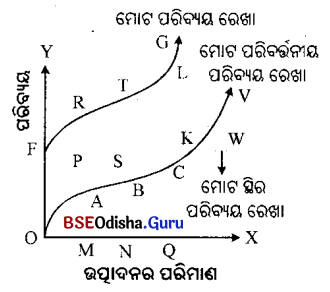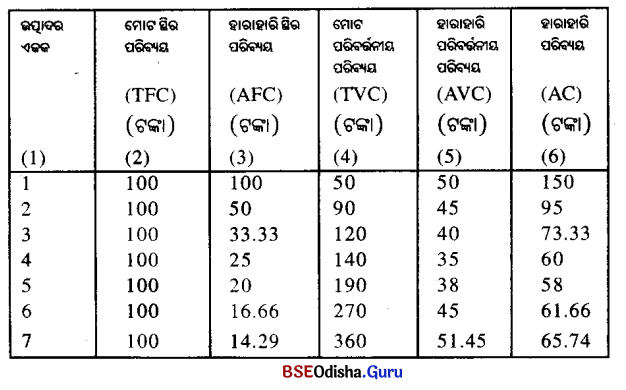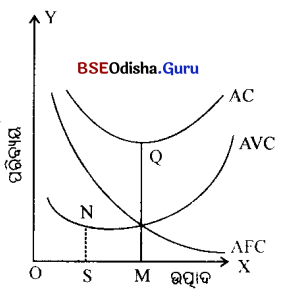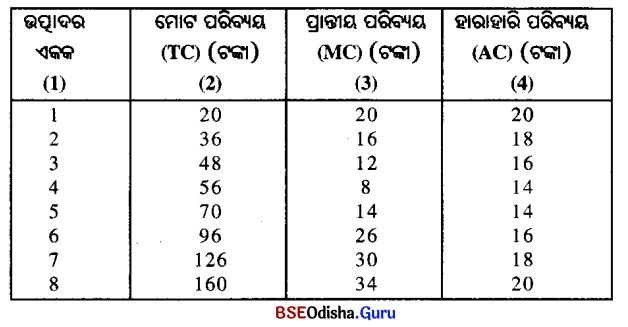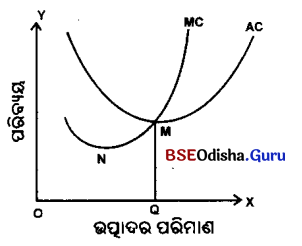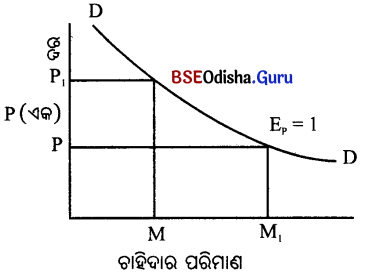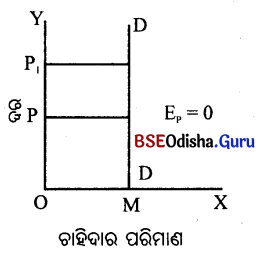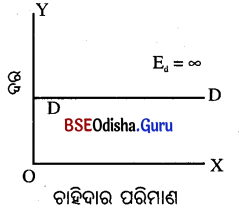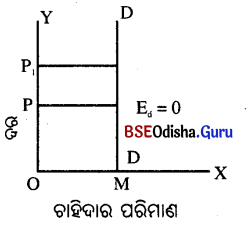Odisha State Board CHSE Odisha Class 12 Political Science Solutions Chapter 4 ଭାରତରେ ଗ୍ରାମାଞ୍ଚଳ ଓ ସହରାଞ୍ଚଳ ସ୍ୱାୟତ୍ତ ଶାସନ ବ୍ୟବସ୍ଥା Long Answer Questions Part-1
CHSE Odisha 12th Class Political Science Chapter 4 Long Answer Questions in Odia Medium Part-1
ଦୀର୍ଘ ଉତ୍ତରମୂଳକ ପ୍ରଶ୍ନୋତ୍ତର
୧ । ସ୍ଥାନୀୟ ସ୍ୱାୟତ୍ତ ଶାସନ ବ୍ୟବସ୍ଥାର ଉଦ୍ଦେଶ୍ୟ ଓ ଆବଶ୍ୟକତା ଆଲୋଚନା କର ।
Answer:
ସ୍ଥାନୀୟ ସ୍ୱାୟତ୍ତ ଶାସନ ଏକ ରାଜନୈତିକ ବ୍ୟବସ୍ଥା ଯାହା ମାଧ୍ୟମରେ କେନ୍ଦ୍ରୀୟ ବା ପ୍ରାଦେଶିକ ବ୍ୟବସ୍ଥାପିକାଦ୍ବାରା ହସ୍ତାନ୍ତରିତ ବା ଅର୍ପିତ କ୍ଷମତାର ପରିସର ମଧ୍ୟରେ ସ୍ଥାନୀୟ ବ୍ୟାପାରସମୂହକୁ ଲୋକମାନଙ୍କର ନିର୍ବାଚିତ ପ୍ରତିନିଧୁମାନଙ୍କ ଦ୍ବାରା ପରିଚାଳନା କରାଯାଇଥାଏ । ଏଣୁ ରାଷ୍ଟ୍ର ଅନୁମୋଦିତ ଢାଞ୍ଚାରେ କ୍ଷୁଦ୍ର ସହରାଞ୍ଚଳ ଓ ଗ୍ରାମାଞ୍ଚଳରେ ସ୍ଥାନୀୟ ବ୍ୟାପାର ପରିଚାଳନାକୁ ସ୍ଥାନୀୟ ସ୍ଵାୟତ୍ତ ଶାସନ ବ୍ୟବସ୍ଥା କୁହାଯାଏ । ଏହା କେନ୍ଦ୍ର ବା ରାଜ୍ୟ ସରକାରୀ କର୍ମଚାରୀମାନଙ୍କଦ୍ୱାରା ପରିଚାଳିତ ସ୍ଥାନୀୟ ଅଞ୍ଚଳର ଶାସନକୁ ସୂଚିତ କରେ ନାହିଁ ବରଂ ସ୍ଥାନୀୟ ଅଞ୍ଚଳର ଲୋକମାନଙ୍କଦ୍ୱାରା ନିର୍ବାଚିତ ପ୍ରତିନିଧୁମାନଙ୍କଦ୍ୱାରା ପରିଚାଳିତ ଓ ନିୟନ୍ତ୍ରିତ ଶାସନକୁ ସ୍ଥାନୀୟ ସ୍ନାୟର ଶାସନ କୁହାଯାଏ ।
ରାଷ୍ଟ୍ର ମଧ୍ୟରେ ଏକ ସୀମିତ ସ୍ଥାନୀୟ ଅଞ୍ଚଳ, କେନ୍ଦ୍ରୀୟ ବା ପ୍ରାଦେଶିକ ବ୍ୟବସ୍ଥାପିକାଦ୍ଵାରା ଅର୍ପିତ ସ୍ଥାନୀୟ କ୍ଷମତା ବା କର୍ତ୍ତୃତ୍ଵ, ସ୍ଥାନୀୟ ଅଞ୍ଚଳର ସ୍ଵାର୍ଥସାଧନ, ସ୍ଥାନୀୟ ଅଞ୍ଚଳରେ ଟିକସ ଧାର୍ଯ୍ୟ ଆଦି ସ୍ଥାନୀୟ ସ୍ୱାୟତ୍ତ ଶାସନ ବ୍ୟବସ୍ଥାର ଉପାଦାନ ଅଟେ । ଗଣତନ୍ତ୍ରର ବାସ୍ତବ ଉପଯୋଗିତା ଦୃଷ୍ଟିରୁ କ୍ଷମତା ବିକେନ୍ଦ୍ରୀକରଣ ସୂତ୍ର ଉପରେ ଆଧାରିତ ଏହି ସ୍ଥାନୀୟ ସ୍ଵାୟତ୍ତ ଶାସନ ବ୍ୟବସ୍ଥାର ଗୁରୁତ୍ଵ ରହିଛି । ଗଣତନ୍ତ୍ର ବର୍ତ୍ତମାନର ସର୍ବୋତ୍କୃଷ୍ଟ ଶାସନ ବ୍ୟବସ୍ଥା ଅଟେ । ଏହା ଲୋକମାନଙ୍କୁ ସ୍ଵତନ୍ତ୍ରତା, ସମାନତା, ନ୍ୟାୟ ପ୍ରଦାନ କରିଥାଏ । କିନ୍ତୁ କୌଣସି ରାଜନୈତିକ ବ୍ୟବସ୍ଥା ସ୍ଵୟଂ-କାର୍ଯ୍ୟକ୍ଷମ ହୋଇପାରୁ ନଥିବାରୁ ଏହାର ସଫଳତା ଏହି ବ୍ୟବସ୍ଥାଧୀନ ଲୋକମାନଙ୍କର ଚରିତ୍ର, ସଚେତନଶୀଳତା, ସାଧୁତା, ଉତ୍ସର୍ଗୀକୃତ କାର୍ଯ୍ୟ ଆଦି ଉପରେ ନିର୍ଭର କରେ ।

ଗଣତନ୍ତ୍ର ଜୀବନଧାରାର ଏକ ପ୍ରକ୍ରିୟା ହିସାବରେ ଏକ ଗଣତାନ୍ତ୍ରିକ ଶାସନ ରୂପରେ ସ୍ଥାନୀୟ ସାୟର ଶାସନ ଏହାର ଭିଭିକୁ ପ୍ରତିଷ୍ଠା କରିଥାଏ । ଏଣୁ ରାଜନୈତିକ ତାଲିମପ୍ରାପ୍ତ ସଚେତନଶୀଳ ନାଗରିକ ଗଣତନ୍ତ୍ରର ସଫଳତା ପାଇଁ ଅନ୍ୟତମ ସର୍ଭ ଅଟେ । ଏହି ପ୍ରକ୍ରିୟା ଶାସନର ସର୍ବନିମ୍ନ ସୋପାନରୁ ଆରମ୍ଭ ହେବା ବିଧେୟ । କ୍ଷମତା ଓ ଦାୟିତ୍ବର ବିକେନ୍ଦ୍ରୀକରଣ ହେବା ଆବଶ୍ୟକ । ଗ୍ରାମ କ୍ଷମତାର ପ୍ରାଥମିକ ସ୍ତର ହେବା ଉଚିତ । ଜାତୀୟ ସ୍ତରରେ ଗଣତନ୍ତ୍ରର ଏନ୍ତୁଡ଼ିଶାଳରୂପେ ସ୍ଥାନୀୟ ସ୍ୱାୟତ୍ତ ଶାସନ ବ୍ୟବସ୍ଥା ପରିଚିତ । ଲର୍ଡ଼ ବ୍ରାଇସିଙ୍କ ମତରେ, ଗଣତନ୍ତ୍ରର ସଫଳତା ପାଇଁ ଏହା ସର୍ବୋତ୍କୃଷ୍ଟ ବିଦ୍ୟାଳୟ ଓ ସର୍ଭ ଅଟେ । ଫରାସୀ ଲେଖକ ଡି. ଟକେଭେଲି ସ୍ଥାନୀୟ ସ୍ୱାୟତ୍ତ ଶାସନକୁ ଏକ ସ୍ବାଧୀନ ଗଣତାନ୍ତ୍ରିକ ରାଷ୍ଟ୍ରର ଶକ୍ତିର ଆଧାର ରୂପେ ସୂଚିତ କରିଛନ୍ତି ।
ସ୍ଥାନୀୟ ସ୍ବାୟତ୍ତ ଶାସନ ବ୍ୟବସ୍ଥାର ଆବଶ୍ୟକତା ଓ ଗୁରୁତ୍ଵ :
- ଗଣତାନ୍ତ୍ରିକ ଶିକ୍ଷା ପ୍ରଦାନ କରି ରାଜନୈତିକ ସଚେତନଶୀଳତା ସୃଷ୍ଟି କରେ – ଏହା ଲୋକମାନଙ୍କୁ ସାଧାରଣ ସ୍ଵାର୍ଥ ହାସଲ ପାଇଁ ଯୁକ୍ତିଯୁକ୍ତ, ସନ୍ତୁଳନ, ସାମାଜିକ ଆବଶ୍ୟକତା, କୌଶଳ ଆଦି ଉପାଦାନର ପ୍ରୟୋଗ କରିବା ମାଧ୍ୟମରେ ଦକ୍ଷତାର ସହ କାର୍ଯ୍ୟ ସମ୍ପାଦନ କରିବା ସମ୍ପର୍କରେ ଶିକ୍ଷା ଦେଇଥାଏ । ଏହା ଆଞ୍ଚଳିକ ବିଷୟ ପ୍ରତି ଗର୍ବଭାବ ଶିକ୍ଷାଦିଏ ଯାହା ପରବର୍ତ୍ତୀ ବୃହତ୍ତର କ୍ଷେତ୍ରରେ ଜାତୀୟ ଅଂଶଗ୍ରହଣ ମାଧ୍ୟମରେ ଏକ ସୁସ୍ଥ ଲୋକହିତକାରୀ ଶାସନ ବ୍ୟବସ୍ଥାର ମୂଳଦୁଆ ଦୃଢ଼ କରିପାରେ ।
- ନାଗରିକ ଚେତନା ଜାଗ୍ରତ କରେ – ସ୍ଥାନୀୟ ସ୍ୱାୟତ୍ତ ଶାସନ ବ୍ୟବସ୍ଥା ଏପରି ଏକ ପରିବେଶ ସୃଷ୍ଟି କରେ ଯାହାଦ୍ଵାରା ନାଗରିକମାନେ ସେମାନଙ୍କର ଅଧିକାର, କର୍ଭବ୍ୟ ଆଦି ସମ୍ପର୍କରେ ଅବଗତ ହୋଇଥା’ନ୍ତି । ଲୋକମାନେ ପ୍ରଶାସନକୁ ଅତି ନିକଟରୁ ଦେଖିବାକୁ ପାଆନ୍ତି ଏବଂ ସେମାନଙ୍କର ସମସ୍ୟାବଳୀର ସମାଧାନ ଲାଗି ପଥ ପରିଷ୍କାର ହୋଇଥାଏ । ଏହାର ପ୍ରଭାବରେ ଜନସାଧାରଣ ନିଜ ସ୍ବାର୍ଥକୁ ତ୍ୟାଗ କରି ଜାତୀୟ ସ୍ଵାର୍ଥସାଧନ ପାଇଁ କାର୍ଯ୍ୟ କରିଥା’ନ୍ତି ।
- ଜନସାଧାରଣଙ୍କୁ ରାଜନୈତିକ ବ୍ୟବସ୍ଥା ପ୍ରତି ଆକୃଷ୍ଟ କରେ – ସ୍ଥାନୀୟ ସଂସ୍ଥାଗୁଡ଼ିକ ନିର୍ଦ୍ଧାରିତ ଅଞ୍ଚଳରେ କାର୍ଯ୍ୟ କରିଥା’ନ୍ତି ଏବଂ ସ୍ଥାନୀୟ ଉଦ୍ୟମରେ ଆଞ୍ଚଳିକ ସମସ୍ୟାର ସମାଧାନ କରିଥା’ନ୍ତି । ଏହା ସ୍ଥାନୀୟ ଜନସାଧାରଣ ଓ ପ୍ରାଦେଶିକ ସରକାର ମଧ୍ୟରେ ଯୋଗସୂତ୍ର ସ୍ଥାପନ କରେ । ଏହା କ୍ଷମତାର ଗଣତାନ୍ତ୍ରିକ ବିକେନ୍ଦ୍ରୀକରଣ ପ୍ରକ୍ରିୟାକୁ ତ୍ଵରାନ୍ଵିତ କରେ । ଏହାଫଳରେ ଜନସାଧାରଣ ରାଜନୈତିକ ବ୍ୟବସ୍ଥା ପ୍ରତି ଆକୃଷ୍ଟ ହୁଅନ୍ତି ।
- ଲୋକମାନଙ୍କ ପାଇଁ ସ୍ଵତନ୍ତ୍ରତାର ବୃହତ୍ତର କ୍ଷେତ୍ର ସୃଷ୍ଟି – ସ୍ଥାନୀୟ ଶାସନ ଲୋକମାନଙ୍କର ସ୍ବତନ୍ତ୍ରତାକୁ ପ୍ରଶସ୍ତ କରେ । ଅମଲାତନ୍ତ୍ରର ପ୍ରଭାବ ଓ ନିୟନ୍ତ୍ରଣରୁ ମୁକ୍ତ ହୋଇ ଲୋକମାନେ ନିଜେ ସାମୂହିକ ପ୍ରଚେଷ୍ଟା କ୍ରମେ ସମସ୍ୟାର ସମାଧାନ କରିଥା’ନ୍ତି । ବ୍ୟକ୍ତି ସ୍ୱତନ୍ତ୍ରତା ପାଇଁ ବ୍ୟକ୍ତି ସର୍ବଦା ଶାଶ୍ୱତ ଜାଗୃତି ରଖୁବା ଆବଶ୍ୟକ । ଏହି ଜାଗୃତି ସୃଷ୍ଟି ପାଇଁ ସ୍ଥାନୀୟ ଶାସନ ତାଲିମକେନ୍ଦ୍ର ରୂପେ କାର୍ଯ୍ୟ କରେ । ଏଣୁ ଏହା ଗଣତନ୍ତ୍ରକୁ ଅଧିକ ଗଣତାନ୍ତ୍ରିକ କରିଥାଏ ।
- ପ୍ରଶାସନିକ ଦକ୍ଷତା ବୃଦ୍ଧି – ଆଧୁନିକ ଜନମଙ୍ଗଳ ରାଷ୍ଟ୍ରରେ ଯୋଜନା ଓ କାର୍ଯ୍ୟକ୍ରମ କେନ୍ଦ୍ରୀକରଣ ନୀତିରେ ପ୍ରସ୍ତୁତ ହେଉଥିଲେ ମଧ୍ୟ ସଫଳତା ଓ ବାସ୍ତବ ଉପଯୋଗିତା ଦୃଷ୍ଟିରୁ ଏହାର ପ୍ରୟୋଗ ବିକେନ୍ଦ୍ରୀକରଣ ନୀତିରେ ହେବା ଆବଶ୍ୟକ । ଜନ ଅଂଶଗ୍ରହଣ ମାଧ୍ୟମରେ ସ୍ଥାନୀୟ ସ୍ତରରେ ଏହାର ପ୍ରୟୋଗ ପ୍ରଶାସନିକ ଦକ୍ଷତା ବୃଦ୍ଧି କରେ ଓ ଶାସନ ନୀତିର ସଫଳତା ଆଣିଦିଏ । କେନ୍ଦ୍ରୀୟ ପ୍ରଶାସନ ଅତ୍ୟଧ୍ଵକ ଶାସନ ଭାରରୁ ମୁକ୍ତ ହୁଏ । ଏହାଫଳରେ କେନ୍ଦ୍ରୀୟ ଶାସନ ମୌଳିକ ଶାସନନୀତି ଓ କାର୍ଯ୍ୟକ୍ରମ ନିର୍ଦ୍ଧାରଣରେ ଅଧିକ ମନୋନିବେଶ କରିବାର ସୁଯୋଗ ପାଏ ।

- କେନ୍ଦ୍ରୀୟ ଓ ପ୍ରାଦେଶିକ ଶାସନର ଅପବ୍ୟବହାର ବିରୁଦ୍ଧରେ ପ୍ରତିଷେଧକ ବ୍ୟବସ୍ଥା – ଏହା କେନ୍ଦ୍ରୀୟ ଓ ପ୍ରାଦେଶିକ ଶାସନର କ୍ଷମତାର ଅପବ୍ୟବହାରକୁ ରୋକିବା ଦିଗରେ ଏକ ଶକ୍ତିଶାଳୀ କ୍ଷେତ୍ର ଅଟେ । ଏହା ସେମାନଙ୍କ ମନମୁଖୀ ଶାସନକୁ ପ୍ରତିରୋଧ କରେ । ଶାସନର ସର୍ବନିମ୍ନ ସୋପାନ ହିସାବରେ ସ୍ଥାନୀୟ ଶାସନକୁ କେନ୍ଦ୍ରୀୟ ଶାସନ ଉପେକ୍ଷା କରିପାରେ ନାହିଁ । ଏହା ଏକ ଚାପଗୋଷ୍ଠୀର ଭୂମିକା ଗ୍ରହଣ କରେ । ଏହା କେନ୍ଦ୍ରୀୟ ତଥା ପ୍ରାଦେଶିକ ଶାସନକୁ ଦିଗ୍ଦର୍ଶନ ଓ ସମର୍ଥନ ପ୍ରଦାନ କରିବା ସଙ୍ଗେ ସଙ୍ଗେ ସେମାନଙ୍କର ଜନସ୍ବାର୍ଥ ବିରୋଧୀ କାର୍ଯ୍ୟକ୍ରମକୁ ବିଫଳ କରି ଗଣତନ୍ତ୍ରକୁ ଦୃଢ଼ କରିଥାଏ ।
- ନବ-ଏକଚ୍ଛତ୍ରବାଦ (New Despotism) ର ସୁସ୍ଥ ପ୍ରତିରୋଧ – ବର୍ତ୍ତମାନ ଆଇନ ପ୍ରଣୟନ, ଆଇନର ପ୍ରୟୋଗ ଓ ଶାସନ କ୍ଷେତ୍ରରେ ଅମଲାତନ୍ତ୍ରର ପ୍ରାଧାନ୍ୟକୁ ଲର୍ଡ଼ ହିୱାର୍ଟ ‘ନବ-ଏକଚ୍ଛତ୍ରବାଦ’ର ଆଖ୍ୟା ଦେଇଛନ୍ତି । ଏହା ବ୍ୟକ୍ତି ସ୍ଵତନ୍ତ୍ରତାକୁ କ୍ଷୁଣ୍ଣ କରୁଛି । ଏଣୁ ସ୍ଥାନୀୟ ସମସ୍ୟାର ସମାଧାନ ପାଇଁ ଅମଲାତନ୍ତ୍ରକୁ ନେତୃତ୍ଵ ନ ଦେଇ ଜନ ଅଂଶଗ୍ରହଣ ମାଧ୍ୟମରେ ଏହା ସଂପାଦନ କରିବା ଅଧ୍ଵକ ଗଣତାନ୍ତ୍ରିକ ଓ ସଫଳତା-ନିର୍ଣ୍ଣାୟକ ହୋଇଥାଏ । ସ୍ଥାନୀୟ ଲୋକପ୍ରତିନିଧୁମାନଙ୍କ ଚାପରେ ଅମଲାତନ୍ତ୍ର ସ୍ଵେଚ୍ଛାଚାରୀ ହୋଇପାରନ୍ତି ନାହିଁ କିମ୍ବା ଜନମତକୁ ଭ୍ରୁକ୍ଷେପ କରିପାରନ୍ତି ନାହିଁ । ତେଣୁ ସ୍ଥାନୀୟ ଶାସନ ଅମଲାତନ୍ତ୍ରର ନବ-ଏକଚ୍ଛତ୍ରବାଦକୁ ପ୍ରତିରୋଧ କରିପାରେ ।
- ସ୍ଥାନୀୟ ଅଭିଜ୍ଞତା ଓ ଲୋକଶକ୍ତିର ପୂର୍ଣ୍ଣ ବିନିଯୋଗ – ସ୍ଥାନୀୟ ଶାସନରେ ସ୍ଥାନୀୟ ଲୋକମାନଙ୍କୁ ଅଣ-ରାଜନୈତିକ ପ୍ରକୃତିସମ୍ପନ୍ନ ସ୍ଥାନୀୟ ଅଭିଜ୍ଞତାଯୁକ୍ତ ନେତୃତ୍ବ ବଳରେ ଲୋକଶକ୍ତିର ପୂର୍ଣ୍ଣ ବିନିଯୋଗଦ୍ଵାରା ସ୍ଥାନୀୟ ସମସ୍ୟାର ସମାଧାନ ସମ୍ଭବ ହୋଇପାରେ । ସର୍ବସାଧାରଣ ସେବାରେ ଏହି ସ୍ଥାନୀୟ ଅଭିଜ୍ଞତାର ବିନିଯୋଗ ପ୍ରଶାସନକୁ ଦକ୍ଷ ଓ ଲୋକାଭିମୁଖୀ କରାଇଥାଏ ।
- ଦଳୀୟ କୁପ୍ରଭାବରୁ ମୁକ୍ତ ଓ ସାମାଜିକ ସଂହତି ପ୍ରତିଷ୍ଠାର ମାଧ୍ୟମ – ଜାତୀୟ ଓ ପ୍ରାଦେଶିକ ଶାସନ ଦଳୀୟ ରାଜନୀତିଦ୍ଵାରା ପ୍ରଭାବିତ ଓ ନିୟନ୍ତ୍ରିତ ହୋଇଥାଏ । ଜାତୀୟ ସ୍ଵାର୍ଥ ଉପରେ ସଂକୀର୍ଷ ଦଳୀୟ ସ୍ଵାର୍ଥ ପ୍ରାଧାନ୍ୟ ବିସ୍ତାର କରେ । କିନ୍ତୁ ସ୍ଥାନୀୟ ଶାସନ ଦଳୀୟ ରାଜନୀତିର କୁପ୍ରଭାବରୁ ଅନେକାଂଶରେ ମୁକ୍ତ ଥାଏ । ଏହା ରାଜନୀତିର ବଳୟ ଭିତରୁ ବାହାରି ସ୍ଥାନୀୟ ସମସ୍ୟାର ସମାଧାନ ଉପରେ ଗୁରୁତ୍ଵ ଦେଇଥାଏ । ଏହା ଜନସମ୍ପର୍କ, ଜନମତର ସମର୍ଥନ, ସହଯୋଗ ଆଦି ଭିତ୍ତି ଉପରେ ଉନ୍ନତ ସାମାଜିକ ସମ୍ପର୍କ ପ୍ରତିଷ୍ଠା କରିଥାଏ । ଏହା ଗଣତନ୍ତ୍ରର ସଫଳତା ଓ ଜାତୀୟ ସଂହତିର ଲକ୍ଷ୍ୟ ହାସଲ ପାଇଁ ସାହାଯ୍ୟ କରେ ।
- ପରୀକ୍ଷା କେନ୍ଦ୍ର ସୃଷ୍ଟି – ଜାତୀୟ ଓ ପ୍ରାଦେଶିକ ସ୍ତରରେ ପ୍ରସ୍ତୁତ ବିଭିନ୍ନ ନୀତିର ପ୍ରୟୋଗ ପାଇଁ ସ୍ଥାନୀୟ ଶାସନ ପରୀକ୍ଷା କେନ୍ଦ୍ର ସୃଷ୍ଟି କରେ । କେତେକ ସ୍ଥାନୀୟ ଶାସନ ଅଞ୍ଚଳରେ ଏହା ପ୍ରୟୋଗ ଫଳରେ ଦୋଷ-ତ୍ରୁଟି ଆଦି ଲକ୍ଷ୍ୟ କରାଯାଏ ଏବଂ ସେହି ସ୍ତରରେ ସଫଳତା ଲାଭ କଲେ ଏହାକୁ ସାର୍ବଜନୀନ କରାଯାଇଥାଏ । ଏଣୁ ସଂଘୀୟ ଏବଂ ଗଣତାନ୍ତ୍ରିକ ରାଷ୍ଟ୍ରରେ ଏହାର ଗୁରୁତ୍ଵ ଯଥେଷ୍ଟ ଅଧ୍ଵ । ଗୋଟିଏ ସ୍ଥାନର ଅଭିଜ୍ଞତାକୁ ଅନ୍ୟ ସ୍ଥାନରେ ସଦୁପଯୋଗ କରାଯାଇପାରେ ।

- ସ୍ଥାନୀୟ ଲୋକମାନଙ୍କୁ ରାଜ୍ୟ ନେତୃତ୍ବର ନିକଟବର୍ତ୍ତୀ କରିଥାଏ ଓ ନେତୃତ୍ବ ତାଲିମ ଦେଇଥାଏ – ସ୍ଥାନୀୟ ଶାସନ ବ୍ୟବସ୍ଥା ଆଞ୍ଚଳିକ ସ୍ତରରେ ନେତୃତ୍ଵ ସୃଷ୍ଟି କରେ ଏବଂ ସ୍ଥାନୀୟ ସଂସ୍ଥାର ନେତୃତ୍ଵରେ ଜୀବନ ଆରମ୍ଭ କରିଥିବା ନେତାମାନେ ଭବିଷ୍ୟତରେ ରାଜ୍ୟ ଓ ଜାତୀୟ ସ୍ତରୀୟ ନେତୃତ୍ଵ ନେଇଥା’ନ୍ତି । ସ୍ଥାନୀୟ ସଂସ୍ଥାର ନିର୍ବାଚନରୁ ଲୋକମାନଙ୍କର ନିର୍ବାଚନ ପ୍ରତି ଆଚରଣ ଓ ନିର୍ଦ୍ଦିଷ୍ଟ ବ୍ୟକ୍ତି ଓ ଦଳ ପ୍ରତି ଥିବା ମନୋଭାବର ପ୍ରମାଣ ମିଳେ । ସ୍ଥାନୀୟ ଶାସନ ଲୋକମାନଙ୍କର ରାଜନୈତିକ ଚେତନା ଜାଗ୍ରତ କରେ । ଏହା ସ୍ଥାନୀୟ ଜନସାଧାରଣଙ୍କୁ ଜିଲ୍ଲା ଓ ରାଜ୍ୟସ୍ତରୀୟ ନେତାମାନଙ୍କ ସଂସ୍ପର୍ଶରେ ଆସିବାକୁ ସୁଯୋଗ ଦେଇଥାଏ । ଏହି ସମସ୍ତ ଗୁରୁତ୍ଵର ବିଶ୍ଳେଷଣରୁ ଏହା ସ୍ପଷ୍ଟ ହୁଏ ଯେ ସ୍ଥାନୀୟ ଶାସନ ଗଣତାନ୍ତ୍ରିକ ସରକାରକୁ ସ୍ଥାୟିତ୍ଵ ପ୍ରଦାନ ଓ ଦକ୍ଷତାଯୁକ୍ତ କରିଥାଏ । ଏହା ଗଣତାନ୍ତ୍ରିକ ଶାସନକୁ ଅଧ୍ଯକ ଦାୟିତ୍ଵଶୀଳ ଓ ଲୋକାଭିମୁଖୀ କରାଇଥାଏ । ଏହା ଲୋକମାନଙ୍କୁ ପ୍ରଶାସନ ରୂପକ କଳା ସମ୍ପର୍କରେ ତାଲିମ ପ୍ରଦାନ କରେ । ବର୍ତ୍ତମାନର ଗଣତାନ୍ତ୍ରିକ ବ୍ୟବସ୍ଥାରେ କ୍ଷମତା ବିକେନ୍ଦ୍ରୀକରଣର ପରିସ୍ଫୁଟନ ଘଟାଇଥିବା ସ୍ଥାନୀୟ ସ୍ଵାୟତ୍ତ ଶାସନର ଗୁରୁତ୍ଵ ବୃଦ୍ଧି ପାଉଛି ।
୨ । ଭାରତରେ ପଞ୍ଚାୟତିରାଜ ବ୍ୟବସ୍ଥାର କ୍ରମବିକାଶ ଧାରା ଆଲୋଚନା କର ।
Answer:
ବର୍ତ୍ତମାନ ଭାରତରେ କାର୍ଯ୍ୟ କରୁଥିବା ପଞ୍ଚାୟତିରାଜ ବ୍ୟବସ୍ଥାର ଇତିହାସ ପ୍ରାଚୀନ ଭାରତର ଇତିହାସର ସମସାମୟିକ ଅଟେ । ଇତିହାସର କ୍ରମବିବର୍ତ୍ତନର ଧାରା ଦେଇ ଏହା ଆଜି ସୁସଂଯତ ଓ ସୁବିନ୍ୟସ୍ତ । ଇତିହାସର କଷଟି ପଥରରେ ଏହାର ଆବଶ୍ୟକତା ପରୀକ୍ଷିତ ଓ ଏହା ଆଜି ସର୍ବଜନ ଆଦୃତ ବ୍ୟବସ୍ଥାରେ ପରିଣତ ହୋଇଛି । ପ୍ରାଚୀନ ଭାରତର ଇତିହାସକୁ ଅନୁଧ୍ୟାନ କଲେ ଉଭୟ ଐତିହାସିକ ଓ ବ୍ୟାବହାରିକ ଦୃଷ୍ଟିରୁ ସ୍ଥାନୀୟ ସ୍ୱାୟତ୍ତ ଶାସନ ବ୍ୟବସ୍ଥାର ଗୁରୁତ୍ଵ ରହିଥିଲା ବୋଲି ସ୍ଵତଃ ପ୍ରମାଣିତ ହୁଏ । ହିନ୍ଦୁ ସଂସ୍କୃତିର ଅଖଣ୍ଡତା, ସ୍ଵାଧୀନତା ଓ ବ୍ୟକ୍ତିତ୍ବ ବା ନିଜତ୍ଵକୁ ସଂରକ୍ଷିତ କରିବା ଦିଗରେ ଏକ ବ୍ୟାପକ ଧରଣର ସ୍ଥାନୀୟ ସରକାର-ବ୍ୟବସ୍ଥା ହିଁ ଅଧିକ ଭାବରେ ଦାୟୀ ବୋଲି ଆମେ ବିବେଚନା କରୁ ।
ଗଣତନ୍ତ୍ରର ବାତାବରଣ ମଧ୍ୟରେ ସ୍ଥାନୀୟ ସ୍ଵାୟତ୍ତ ସରକାର ଏକ ମୌଳିକ ସଙ୍ଗଠନରେ ପରିଣତ ହୋଇଯାଇଛି । ଏହାର ଗୁରୁତ୍ଵ ଉପରେ ଡବ୍ଲ୍ୟୁ.ଏ. ରବସନ୍ (W.A. Robson) ଙ୍କ ପ୍ରଦତ୍ତ ମତ ପ୍ରଣିଧାନଯୋଗ୍ୟ । ତାଙ୍କ ମତରେ,“ ସୀମିତ ଭୂଖଣ୍ଡ ମଧ୍ଯରେ ସ୍ଵାୟତ୍ତ ସରକାର ସ୍ଥାନୀୟ ଜନସାଧାରଣଙ୍କୁ ଆଞ୍ଚଳିକ ସମସ୍ୟାଗୁଡ଼ିକର ଯତ୍ନ ନେବା ସକାଶେ ପ୍ରତିନିସ୍ ବାଛିବା ନିମିତ୍ତ ସାମର୍ଥ୍ୟ ପ୍ରଦାନ କରିଥାଏ ।” ଜନସ୍ୱାସ୍ଥ୍ୟ, ଶିକ୍ଷା, ସାଧାରଣ କଲ୍ୟାଣ ପ୍ରଭୃତି ମୌଳିକ ପ୍ରୟୋଜନ ଏବଂ ସ୍ଥାନୀୟ ସ୍ଵାର୍ଥସିଦ୍ଧି ନିମିତ୍ତ ସ୍ଥାନୀୟ ସଂସ୍ଥା ମାଧ୍ୟମରେ ଗଣତାନ୍ତ୍ରିକ କ୍ଷମତାର ବିକେନ୍ଦ୍ରୀକରଣ ସମ୍ଭବ ହୋଇଥାଏ । ଜାତୀୟ ପୁନର୍ଗଠନର ବିବିଧ କାର୍ଯ୍ୟ ଏହି ଶାସନ ସଂସ୍ଥାର ସହଯୋଗ, ସହାୟତା ଏବଂ ସମର୍ଥନ ମାଧ୍ୟମରେ ସମାହିତ ହୋଇଥାଏ ।

ଏହି ସଂସ୍ଥାର ଗୁରୁତ୍ଵ ସମ୍ପର୍କରେ ଭି.ଭି. ରାଓ ଓ ଏନ୍. ହଜାରିକା ତାଙ୍କର ‘ଭାରତରେ ସ୍ଵାୟତ୍ତ ଶାସନ ବ୍ୟବସ୍ଥା” (Local-Self Government in India) ପୁସ୍ତକରେ ଉଲ୍ଲେଖ କରିଛନ୍ତି ଯେ ଏହା ବ୍ୟକ୍ତିର ମୌଳିକ ଅଧିକାରର ସୁରକ୍ଷା କରିବା ସଙ୍ଗେ ସଙ୍ଗେ ସୁନାଗରିକତା ଏବଂ ନିଃସ୍ବାର୍ଥପର ହେବା ସମ୍ପର୍କରେ ଶିକ୍ଷା ପ୍ରଦାନ କରି ଏକ ଉତ୍ତମ ମାଧ୍ୟମ ରୂପେ କାର୍ଯ୍ୟ କରିଥାଏ । ସ୍ନେହ, ପ୍ରୀତି ଇତ୍ୟାଦି ଦିବ୍ୟଗୁଣ ପ୍ରଥମେ ପରିବାରରୁ ଆରମ୍ଭ ହେବା ଭଳି ପ୍ରାଥମିକ ସ୍ତରରେ ସ୍ୱାୟତ୍ତ ଶାସନରେ ଅଂଶଗ୍ରହଣ କରି ବ୍ୟକ୍ତି ଗଣତାନ୍ତ୍ରିକ ଜୀବନଯାପନ ନିମିତ୍ତ ନାଗରିକତା ଓ ରାଜନୈତିକ ଶିକ୍ଷା ପାଇଥାଏ । ଜାତୀୟ ଐକ୍ୟ ଓ ସଂହତି ପ୍ରତିଷ୍ଠା ଓ ସୁରକ୍ଷା ଦିଗରେ ନାଗରିକମାନଙ୍କୁ ଅଂଶଗ୍ରହଣ କରିବାର ସୁବର୍ଣ୍ଣ ସୁଯୋଗ ଏହି ବ୍ୟବସ୍ଥା ମାଧ୍ୟମରେ ଯୋଗାଇ ଦିଆଯାଇଥାଏ ।
ଏଣୁ ଏହା ପୃଥିବୀର ବିଭିନ୍ନ ଦେଶରେ ବିଭିନ୍ନ ରୂପ ନେଇ କାର୍ଯ୍ୟ କରୁଛି ଓ ପ୍ରତ୍ୟେକ ଦେଶର ପ୍ରିୟ ବ୍ୟବସ୍ଥା ରୂପେ ସୂଚିତ ହୋଇଛି । ଅଧୁନାତମ ପୃଥିବୀରେ କାର୍ଯ୍ୟ କରୁଥିବା ସ୍ଵାୟତ୍ତ ଶାସନ ବ୍ୟବସ୍ଥାକୁ ମୁଖ୍ୟତଃ ପାଞ୍ଚଭାଗରେ ବିଭକ୍ତ କରାଯାଇଥାଏ, ଯଥା –
- ଐକକେନ୍ଦ୍ରୀୟ (Unitary),
- ବିକେନ୍ଦ୍ରୀୟ (Decentralised),
- ନେପୋଲିଓ ଢାଞ୍ଚାରେ ପୂର୍ଣ୍ଣାଙ୍ଗ ବ୍ୟବସ୍ଥା (Nepoleonic perfect)
- କମ୍ୟୁନିଷ୍ଟ ରାଷ୍ଟ୍ରର ସଂଘୀୟ ବିକେନ୍ଦ୍ରୀକରଣ ବ୍ୟବସ୍ଥା (Federal Decentralisation in Communist Countries) ଓ
- ଉତ୍ତର ଔପନିବେଶିକ ବ୍ୟବସ୍ଥା (Post Colonial system) । ଭାରତରେ ଦ୍ଵିତୀୟ ପ୍ରକାରର ସ୍ୱାୟତ୍ତ ଶାସନ ବ୍ୟବସ୍ଥା ପରିଦୃଷ୍ଟ ହୁଏ ଏବଂ ଏହା ସାଧାରଣତଃ ଦୁଇ ସ୍ତରବିଶିଷ୍ଟ, ଯଥା (a) ଗ୍ରାମ୍ୟ ଓ (b) ପୌର ।
1. ଭାରତରେ ଏହି ବ୍ୟବସ୍ଥାର ଅତୀତ ପରମ୍ପରା – ବେଦ ଭାରତର ପ୍ରାଚୀନତମ ଗ୍ରନ୍ଥ ଅଟେ । ଋଗ୍ବେଦରେ ନଗରର ଶାସନମୁଖ୍ୟ ବା ପୁରପତିଙ୍କ ବିଷୟରେ ବର୍ଣ୍ଣନା କରାଯାଇଛି । ବେଦ ହିଁ ପ୍ରାଚୀନ ଭାରତର ଉଭୟ ପୌର ଓ ଗ୍ରାମ୍ୟ ସ୍ଥାନୀୟ ସ୍ୱାୟତ୍ତ ଶାସନ ବ୍ୟବସ୍ଥା କାର୍ଯ୍ୟ କରୁଥିବାର ପ୍ରମାଣ ଦେଇଥାଏ । ପରବର୍ତ୍ତୀ ସ୍ଵାୟତ୍ତ ଶାସନ ବିଷୟକ ବର୍ଣ୍ଣନା “ମନୁ ସଂହିତା”ରୁ ମିଳିଥାଏ । ମନୁଙ୍କୁ ବେଦର ପରବର୍ତ୍ତୀ ସାମାଜିକ ନୀତିଶାସ୍ତ୍ରର ପ୍ରଣୟନକର୍ତ୍ତା ରୂପେ ଗ୍ରହଣ କରାଯାଇଥାଏ । ମନୁ ସଂହିତା ଅନୁଯାୟୀ ପ୍ରତ୍ୟେକ ସହରରେ ସମସ୍ତ ବିଷୟ ସମାଧାନ ନିମିତ୍ତ “ ସର୍ବାର୍ଥ ଚିନ୍ତକ” (Sarbartha Chintaka) ନାମରେ ଜଣେ ଅଧୁରକ୍ଷକଙ୍କୁ ନିଯୁକ୍ତି ଦିଆଯାଇଥିଲା । ମନୁଙ୍କ ସମୟରେ ଗ୍ରାମ୍ୟ ପ୍ରଶାସନିକ କର୍ମଚାରୀ ସରକାରୀ କର୍ମଚାରୀଭାବେ ଗଣ୍ୟ ହେଲେ ।
ଭାରତରେ ଏହି ବ୍ୟବସ୍ଥାର କ୍ରମବିକାଶର ପରବର୍ତ୍ତୀ ଚିତ୍ର କୌଟିଲ୍ୟଙ୍କ “ ଅର୍ଥଶାସ୍ତ୍ର ” ରୁ ମିଳିଥାଏ । ଅର୍ଥଶାସ୍ତ୍ରରେ ଗ୍ରାମ୍ୟ ସଙ୍ଗଠନ ଓ ପରିଚାଳନା ନିମିତ୍ତ ସରକାରୀ ଅଧ୍ଵରକ୍ଷକଙ୍କର ଦାୟିତ୍ଵ ବିଷୟରେ ଉଲ୍ଲେଖ ରହିଛି । ଅର୍ଥଶାସ୍ତ୍ରର ବ୍ୟବସ୍ଥା ଅନୁଯାୟୀ ରାଜା ପ୍ରତି ଆଠଶହ ଗ୍ରାମ ମଧ୍ଯରେ ଗୋଟିଏ ‘ସ୍ଥାନୀୟମ’, ଚାରିଶହ ଗ୍ରାମ ମଧ୍ୟରେ ‘ଦ୍ରୋଣମୁଖ’, ଦୁଇଶହ ଗ୍ରାମ ମଧ୍ୟରେ ଗୋଟିଏ ‘କର୍କଟିକା’ ଏବଂ ପ୍ରତି ଦଶଟି ଗ୍ରାମ ମଧ୍ୟରେ ଏକ ‘ସଂଗ୍ରହଣମ୍’ ସ୍ଥାପନ କରିବାର ଯେଉଁ ନିର୍ଦ୍ଦେଶ ରହିଛି ତାହା ଏହି ବ୍ୟବସ୍ଥାର ଅତୀତ ସ୍ଥିତିକୁ ସୂଚିତ କରିଥାଏ । ଏତଦ୍ବ୍ୟତୀତ ପରବର୍ତ୍ତୀ ପର୍ଯ୍ୟାୟରେ ମେଘାସ୍ଥିନିସ୍କଙ୍କ ବିବରଣୀ ମଧ୍ଯ ମଗଧର ରାଜଧାନୀ ପାଟଳୀପୁତ୍ରର ଶାସନ ଏକ ପୌର ପରିଷଦଦ୍ଵାରା ପରିଚାଳିତ ହେଉଥିଲା ବୋଲି ସୂଚନା ଦେଇଥାଏ । ତେଣୁ ଖ୍ରୀ.ପୂ. ତୃତୀୟ ଶତାବ୍ଦୀରେ ମଧ୍ଯ ଏହାର ସ୍ଥିତି ରହିଥିଲା ବୋଲି ସ୍ପଷ୍ଟ ପ୍ରମାଣ ମିଳୁଛି ।

ଚୋଳ, ପଲ୍ଲବ, ପାଣ୍ଡ୍ଯ ଓ ବିଜୟନଗରମ୍ ଇତ୍ୟାଦି ରାଜ୍ୟରେ ରାଜାଙ୍କ ରାଜତ୍ଵ ସମୟରେ ସଭା, ସମିତି, ଅର୍ସ (Urs), ନାଡୁ (Nadu), ମଣ୍ଡଳମ୍ (Mandalam) ଇତ୍ୟାଦି ସଙ୍ଗଠନ ସ୍ଵାୟତ୍ତ ଶାସନ ବ୍ୟବସ୍ଥାର ପ୍ରମାଣ ଦେଇଥାଏ । ଗ୍ରାମାଞ୍ଚଳରେ ସ୍ୱାୟତ୍ତ ଶାସନ ବ୍ୟବସ୍ଥାର ସ୍ଥିତି ସମ୍ପର୍କରେ ଅନେକ ପ୍ରମାଣ ଅଛି । ଚୋଳ ସମ୍ରାଟ ପ୍ରଥମ ପ୍ରଭୃତକ (Pravtaka – 1) ଙ୍କ ସମୟରେ ୯୧୯ ଓ ୯୨୧ ଖ୍ରୀ.ଅ.ର ଉତ୍ତରମେରୁ ଅଭିଲେଖ (Uttarameru Inscription) ରେ ଗ୍ରାମଗୁଡ଼ିକ ଅନେକ ସମିତିଦ୍ଵାରା ଶାସିତ ହେଉଥିଲା ବୋଲି ଉଲ୍ଲେଖ ରହିଛି । ଉତ୍ତର ଭାରତରେ ଏହି ଗ୍ରାମ୍ୟସ୍ତରୀୟ ମୁଖୁଆମାନଙ୍କୁ ‘ଗ୍ରାମିକ’ ବା ‘ଗ୍ରାମୋୟକ’ କୁହାଯାଉଥିଲାବେଳେ ଦାକ୍ଷିଣାତ୍ୟର ପୂର୍ବାଞ୍ଚଳରେ ‘ମୁନୁଣ୍ଡା’ ନାମରେ, ମହାରାଷ୍ଟ୍ରରେ ‘ଗ୍ରାମକୁଟ’ ବା ‘ପୋଟ୍ଟକିଳା’ ନାମରେ, କର୍ଣାଟକରେ ‘ଗୌଣ୍ଡା’ ନାମରେ ଏବଂ ଉତ୍ତରପ୍ରଦେଶରେ ‘ମହାରକ’ ବା ‘ମହାନ୍ତକ’ ନାମରେ ସେମାନେ ପରିଚିତ ଥିଲେ ।
ଭାରତରେ ମୋଗଲ ଓ ମରହଟ୍ଟା ରାଜତ୍ଵ ସମୟରେ ପୌର ଶାସନ ସଂସ୍ଥା କାର୍ଯ୍ୟ କରୁଥିଲା । ‘କଟୁଆଳ’ ନାମକ କର୍ମଚାରୀ ଏହି ପୌର ଶାସନକୁ ପରିଚାଳନା କରୁଥିଲେ । ଏହି ବିଷୟ ‘ଆଇନ-ଇ-ଆକବରୀ’ ନାମକ ପୁସ୍ତକରେ ବର୍ଣ୍ଣିତ ହୋଇଛି । ମୁସଲମାନ ରାଜତ୍ଵ ସମୟରେ ଜାଗିର ବ୍ୟବସ୍ଥାର ପ୍ରଚଳନ କରାଯାଇ ‘ମାଲ୍ଗୁଜାରସ୍’ (Malguzars) ମାନଙ୍କଦ୍ବାରା ରାଜସ୍ୱ ଆଦାୟ ବ୍ୟବସ୍ଥା କରାଯାଇଥିଲା ଓ ଏହି ସମୟରେ ପଞ୍ଚାୟତ ବ୍ୟବସ୍ଥାର ବିପର୍ଯ୍ୟୟ ଘଟିଥିଲା । ପଞ୍ଚାୟତର କ୍ଷମତାକୁ ଜମିଦାର ଓ ସରକାରୀ କର୍ମଚାରୀଙ୍କୁ ହସ୍ତାନ୍ତର କରାଯାଇ ପଞ୍ଚାୟତ ବ୍ୟବସ୍ଥାର ସ୍ଥିତିକୁ ଦୁର୍ବଳ କରି ଦିଆଗଲା ।
2. ବ୍ରିଟିଶ୍ ଶାସନାଧୀନ ଭାରତରେ ଏହାର ସ୍ଥିତି – ଭାରତରେ ଗ୍ରାମ୍ୟସ୍ତରୀୟ ସ୍ଵାୟତ୍ତ ଶାସନ ବ୍ୟବସ୍ଥା ବା ଗ୍ରାମପଞ୍ଚାୟତର ବିକାଶ ଇଷ୍ଟ-ଇଣ୍ଡିଆ କମ୍ପାନୀ ତଥା ବ୍ରିଟିଶ୍ ସରକାରଙ୍କର ଶାସନ ସମୟରେ ଯଥେଷ୍ଟ ଭାବରେ ହୋଇପାରିନଥିଲା । ଇଷ୍ଟ-ଇଣ୍ଡିଆ କମ୍ପାନୀଠାରୁ କ୍ଷମତା ବ୍ରିଟିଶ୍ ସରକାର ହାତକୁ ଗଲା ପରଠାରୁ ଏହି ସ୍ଵାୟତ୍ତ ଶାସନ ବ୍ୟବସ୍ଥାର କ୍ରମବିକାଶର ଧାରା ତ୍ୱରାନ୍ବିତ ହୋଇଥିଲା ଓ ସେ ଦ୍ଵିତୀୟ ଜେମ୍ସଙ୍କଠାରୁ ମାନ୍ଦ୍ରାଜ ସହରରେ ନିଗମ ପ୍ରତିଷ୍ଠା ନିମନ୍ତେ ଅନୁମତି ପାଇଥିଲେ । ୧୬୮୮ ମସିହା ସେପ୍ଟେମ୍ବର ୨୮ ତାରିଖରେ ପ୍ରଥମ ପୌର ନିଗମ ତା’ର କାର୍ଯ୍ୟ ଆରମ୍ଭ କରିଥିଲା । ୧୭୨୬ ମସିହାରେ ପୌର ନିଗମର କ୍ଷମତା ପରିସରକୁ ବୃଦ୍ଧି କରାଯାଇଥିଲା ।
୧୭୯୩ ମସିହାର ଚାର୍ଟର ଆଇନ ବଳରେ ମାନ୍ଦ୍ରାଜ, କଲିକତା ଏବଂ ବମ୍ବେ ପ୍ରଭୃତି ତିନିଗୋଟି ପ୍ରେସିଡ଼େନ୍ସୀ ସହରରେ ପୌର ଶାସନ ପ୍ରବର୍ଣିତ ହେଲା । ମାତ୍ର ୧୮୫୮ ମସିହା ପର୍ଯ୍ୟନ୍ତ ଭାରତର ଶାସନ ବ୍ୟବସ୍ଥା ଇଷ୍ଟ-ଇଣ୍ଡିଆ କମ୍ପାନୀଦ୍ଵାରା ପରିଚାଳିତ ହୋଇଥିଲା ଓ ଉପରିଲିଖୂତ ବ୍ୟବସ୍ଥା ସତ୍ତ୍ଵେ ଏହି ସ୍ୱାୟତ୍ତ ଶାସନ ପରମ୍ପରା କେବଳ ନାମକୁ ମାତ୍ର ଭାବରେ ଭାରତରେ ବଞ୍ଚ୍ ରହିଥିଲା । ୧୮୩୦ ମସିହାରେ ସାର୍ ଚାର୍ଲସ୍ ମେଟ୍ଫ (Charles Metcalf) ଭାରତର ଗ୍ରାମ ସମାଜଗୁଡ଼ିକୁ ‘କ୍ଷୁଦ୍ର ସାଧାରଣତନ୍ତ୍ର’ (Little Republic) ରୂପେ ନାମିତ କରି ଏହି ସଙ୍ଗଠନର ଗୁରୁତ୍ଵ ସମ୍ପର୍କରେ ମତ ଦେଇଥିଲେ । ଏହାପରେ ୧୮୪୨ ମସିହାରେ ବିଧ୍ଵବଦ୍ଧ ଭାବେ ପୌର ସମିତି ଗଠନ ପାଇଁ ପ୍ରଥମ ଆଇନ ବଙ୍ଗଳାର ପ୍ରାଦେଶିକ ସରକାରଙ୍କ ଆଇନ ନମ୍ବର ୧୦ ମାଧ୍ୟମରେ ପ୍ରଣୀତ ହେଲା ।

ଏହି ଆଇନ ଏହାକୁ ଏକ ଇଚ୍ଛାଧୀନ ବିଷୟରେ ପରିଣତ କରିଥିବାରୁ ଲୋକପ୍ରିୟତା ଅର୍ଜନ କରିପାରିନଥିଲା । ୧୮୫୮ ବିଦ୍ରୋହ ପରେ ଇଷ୍ଟଇଣ୍ଡିଆ କମ୍ପାନୀଠାରୁ ବ୍ରିଟିଶ ରାଣୀଙ୍କୁ ଶାସନ କ୍ଷମତା ହସ୍ତାନ୍ତରିତ ହେଲା । ଇଷ୍ଟଇଣ୍ଡିଆ କମ୍ପାନୀର ମୂଳ ଉଦ୍ଦେଶ୍ୟ ଥିଲା ବାଣିଜ୍ୟ ବ୍ୟବସାୟ; କିନ୍ତୁ ବ୍ରିଟିଶ୍ ପାର୍ଲିଆମେଣ୍ଟଦ୍ୱାରା ଶାସନ ପରିଚାଳିତ ହେବାରୁ ଏହାର ଉଦ୍ଦେଶ୍ୟ କେବଳ ‘ଶାସନ’ରେ ହିଁ ପର୍ଯ୍ୟବସିତ ହେଲା । ଏହା ଫଳରେ ୧୮୬୦ ଠାରୁ ୧୮୭୦ ମଧ୍ୟରେ ମୁଖ୍ୟତଃ ଦୁଇଟି ଆଇନ – (୧୮୬୭ରେ ମାନ୍ଦ୍ରାଜ ଓ ୧୮୬୮ରେ କଲିକତାରେ ନିଗମ (Corporation) ପ୍ରତିଷ୍ଠା ସଂକ୍ରାନ୍ତୀୟ) ମାଧ୍ୟମରେ ଶାସନ ପ୍ରତି ଜନସମର୍ଥନ ବୃଦ୍ଧି ପାଇଁ ବ୍ରିଟିଶ୍ ସରକାର ସ୍ଵାୟତ୍ତ ଶାସନକୁ ପୁନଃ ପ୍ରତିଷ୍ଠିତ କଲେ । ୧୮୭୦ ମସିହାରେ ସ୍ଵାୟତ୍ତ ଶାସନ ବ୍ୟବସ୍ଥାର କ୍ରମବିକାଶର ଗତି ଅଧିକ ତ୍ବରାନ୍ବିତ ହେଲା ।
ଉକ୍ତ ବର୍ଷ ଲର୍ଡ଼ ମେୟୋ (Lord Mayo) ଙ୍କ ପ୍ରସ୍ତାବ ଫଳରେ ରାଜନୈତିକ କ୍ଷମତାର ବିକେନ୍ଦ୍ରୀକରଣଦ୍ବାରା ସ୍ଵାୟତ୍ତ ଶାସନର ଆଧୁନିକୀକରଣ ସମ୍ଭବପର ହୋଇପାରିଥିଲା । ଶିକ୍ଷାର ବିକାଶ ଓ ପାଶ୍ଚାତ୍ୟ ସଭ୍ୟତାର ପ୍ରତିଫଳନ ଭାରତୀୟମାନଙ୍କ ଉପରେ ପଡ଼ିବାରୁ ସ୍ଵାୟତ୍ତ ଶାସନ ବ୍ୟବସ୍ଥାର ଉନ୍ନତି ପାଇଁ ବ୍ରିଟିଶ୍ ସରକାର ବାଧ୍ୟ ହୋଇଥିଲେ । ୧୮୨୨ ମସିହାରେ ଲର୍ଡ଼ ରିପନଙ୍କର ଶାସନ ସଂସ୍କାରଦ୍ୱାରା ଭାରତୀୟମାନଙ୍କର ସ୍ଵାୟତ୍ତ ଶାସନ ସମ୍ପର୍କୀୟ କ୍ରମବର୍ଦ୍ଧିଷ୍ଣୁ ଆଶା ଓ ଆକାଂକ୍ଷା ପୂରଣ ହେଲା ଏବଂ ତାଙ୍କୁ ସାଧାରଣତଃ ଆଧୁନିକ ଭାରତର ସ୍ଵାୟତ୍ତ ଶାସନ ବ୍ୟବସ୍ଥାର ଜନକ ରୂପେ ଅଭିହିତ କରାଯାଇଥାଏ । ସ୍ୱାୟତ୍ତ ଶାସନ ବ୍ୟବସ୍ଥା ଇତିହାସରେ ଅନ୍ୟ ଏକ ତାତ୍ପର୍ଯ୍ୟପୂର୍ଣ୍ଣ ଘଟଣା ହେଉଛି ୧୯୦୭ ମସିହାର ବିକେନ୍ଦ୍ରୀକରଣ ସମ୍ବନ୍ଧୀୟ ରୟାଲ କମିଶନଙ୍କର ପ୍ରସ୍ତାବ (Royal Commission on Decentralisation, 1907) ଓ ୧୯୦୯ ମସିହାର ଏହି ସମ୍ପର୍କୀୟ ଘୋଷଣାନାମା ।
ଏହି ନୀତି ଫଳରେ କେବଳ ଗ୍ରାମମାନଙ୍କୁ ସ୍ୱାୟତ୍ତ ଶାସନ କ୍ଷମତା ପ୍ରଦାନ କରିବାପାଇଁ ଓ ପ୍ରତ୍ୟେକ ଗ୍ରାମରେ ପଞ୍ଚାୟତ ଓ ସହରରେ ପୌରସଂସ୍ଥା ପ୍ରତିଷ୍ଠା ପାଇଁ ବ୍ୟବସ୍ଥା କରାଗଲା । ଏହି ସ୍ଵାୟତ୍ତ ଶାସନ ସଂସ୍ଥାରେ ସଂଖ୍ୟାତ୍ମକ ନିର୍ବାଚିତ ସଭ୍ୟ ରହିବା ଉଚିତ ବୋଲି ମତପ୍ରକାଶ ପାଇଲା ଓ ଏହାକୁ ନିର୍ଦ୍ଦିଷ୍ଟ କ୍ଷମତା ପ୍ରଦାନ ପାଇଁ କାର୍ଯ୍ୟପନ୍ଥା ଗ୍ରହଣ କରାଗଲା । ୧୯୦୯ର ଏହି ବ୍ୟବସ୍ଥା ଉପଯୁକ୍ତ ଦୃଷ୍ଟି ଆକର୍ଷଣ କରିପାରିଲା ନାହିଁ । ମାତ୍ର ୧୯୧୯ ମସିହାରେ ଭାରତ ଶାସନ ଆଇନ ସ୍ଵାୟତ୍ତ ଶାସନ ଦିଗରେ ସ୍ବତନ୍ତ୍ର ବିଧ୍ଵବ୍ୟବସ୍ଥା ପ୍ରଚଳନ କଲା । ଏହି ଆଇନର ବ୍ୟବସ୍ଥା ଅନୁଯାୟୀ ୮ (ଆଠ) ଗୋଟି ପ୍ରାଦେଶିକ ସରକାର ସ୍ନାୟତ୍ତ ଶାସନ ନିମିତ୍ତ ବିଭିନ୍ନ ଆଇନ ପ୍ରଣୟନ କଲେ ।
୧୯୩୫ର ଭାରତ ଶାସନ ଆଇନଦ୍ଵାରା ପ୍ରାଦେଶିକ ସରକାରମାନଙ୍କୁ ସ୍ବତନ୍ତ୍ର କ୍ଷମତା ଦିଆଗଲା ଓ ସ୍ୱାୟତ୍ତ ଶାସନ ବ୍ୟବସ୍ଥାକୁ ପ୍ରାଦେଶିକ ସରକାରଙ୍କ କ୍ଷମତା ପରିସରଭୁକ୍ତ କରାଗଲା । ୧୯୩୮ ମସିହାରେ ଭାରତର ତଦାନୀନ୍ତନ ସ୍ଵାୟତ୍ତ ଶାସନ ବିଭାଗର ମନ୍ତ୍ରୀ ଡକ୍ଟର ଡି.ପି. ମିଶ୍ରଙ୍କର ପ୍ରସ୍ତାବ ଓ ଯୋଜନା ଅନୁଯାୟୀ ସ୍ଵାୟତ୍ତ ଶାସନ ବ୍ୟବସ୍ଥାର ପୁନର୍ଗଠନ ପାଇଁ କେତେକ ପଦକ୍ଷେପ ନିଆଯାଇଥିଲା । ଏ ସମସ୍ତ କାର୍ଯ୍ୟକ୍ରମ ସତ୍ତ୍ଵେ, ଭାରତରେ ସ୍ଵାୟର ବ୍ୟବସ୍ଥା ଦେଶରେ ସ୍ଵାୟତ୍ତ ଶାସନ ସଂସ୍କାର ପାଇଁ ଅଭିପ୍ରେତ ନ ହୋଇ ବ୍ରିଟିଶ୍ ସରକାରଙ୍କର ଉଦ୍ଦେଶ୍ୟ ପୂରଣ ନିମିତ୍ତ କାର୍ଯ୍ୟ କରିବାରୁ, ଏହି ବ୍ୟବସ୍ଥାର ଲକ୍ଷ୍ୟ ପୂରଣ ନ ହେବା ସଙ୍ଗେ ସଙ୍ଗେ ଏହାର ସ୍ଥିତି ସେତେ ମଜଭୁତ ହୋଇପାରି ନଥିଲା ।
3. ସ୍ବାଧୀନତୋତ୍ତର ଭାରତରେ ଏହାର ସ୍ଥିତି ଓ ପ୍ରକୃତି :
୧୯୫୦ ମସିହାରେ ସ୍ଵାଧୀନ ଭାରତର ନୂତନ ସମ୍ବିଧାନ କାର୍ଯ୍ୟକାରୀ ହେଲା । ନୂତନ ସମ୍ବିଧାନର ଚତୁର୍ଥ ଖଣ୍ଡର ରାଷ୍ଟ୍ର ନିୟାମକ ତତ୍ତ୍ଵ (Directive Principles of State Policy) ସମ୍ପର୍କୀୟ ବିଷୟର ୪୦ ଧାରା ଅନୁଯାୟୀ ରାଷ୍ଟ୍ର ଗ୍ରାମପଞ୍ଚାୟତର ସଙ୍ଗଠନ ପାଇଁ ପଦକ୍ଷେପ ନେବା ଓ ଏହାକୁ ଉପଯୁକ୍ତ କ୍ଷମତା ପ୍ରଦାନ କରି ସ୍ୱାୟତ୍ତ ଶାସନ ବ୍ୟବସ୍ଥାର ଏକ ଅଙ୍ଗ ରୂପେ କାର୍ଯ୍ୟ କରିବାର ସମସ୍ତ ସୁବିଧା ଯୋଗାଇଦେବା ନିମନ୍ତେ ସ୍ବାୟତ୍ତ ଶାସନ ବ୍ୟବସ୍ଥାକୁ ରାଜ୍ୟ ସରକାରଙ୍କର କ୍ଷମତା ପରିସରଭୁକ୍ତ କରାଯାଇଛି । ବିଭିନ୍ନ ଆଇନ ପ୍ରଣୟନ ମାଧ୍ୟମରେ ସମ୍ବିଧାନର ଏହି ନୀତିକୁ କାର୍ଯ୍ୟକାରୀ କରିବାର ବ୍ୟବସ୍ଥା କରାଯାଇଛି । ଗଣତନ୍ତ୍ରର ମୂଳମନ୍ତ୍ର ଅନୁଯାୟୀ ସ୍ୱାୟତ୍ତ ଶାସନ ବ୍ୟବସ୍ଥାରେ ଲୌକିକ ନିର୍ବାଚିତ ସରକାର ପ୍ରତିଷ୍ଠାର ଲକ୍ଷ୍ୟ ରଖାଯାଇଛି ।

ସାର୍ବକାଳୀନ ସାବାଳକ ଭୋଟ ପ୍ରଥା (Universal Adult Franchise) ର ଅବଲମ୍ବନରେ ପଞ୍ଚାୟତ ସଂସ୍ଥାର ନିର୍ବାଚନ ଅନୁଷ୍ଠିତ ହେଉଛି । ଏହି ବ୍ୟବସ୍ଥାର ସଫଳ ରୂପାୟନ ପାଇଁ ୧୯୫୨ ମସିହା ଅକ୍ଟୋବର ୨ ତାରିଖ ଦିନ ଗୋଷ୍ଠୀ ଉନ୍ନୟନ କାର୍ଯ୍ୟକ୍ରମ (Community Development Programme) ଓ ୧୯୫୩ ମସିହା ଅକ୍ଟୋବର ୨ ତାରିଖ ଦିନ ଜାତୀୟ ସଂପ୍ରସାରଣ ଯୋଜନା (National Extension Service) କାର୍ଯ୍ୟକାରୀ କରାଗଲା । ମାତ୍ର କେତେକ ସଙ୍ଗଠନଜନିତ ତ୍ରୁଟି ପାଇଁ ଗୋଷ୍ଠୀ ଉନ୍ନୟନ କାର୍ଯ୍ୟକ୍ରମ ସେତେମାତ୍ରାରେ ସଫଳ ହୋଇପାରିଲା ନାହିଁ । ତେଣୁ ଏହି ଦୋଷତ୍ରୁଟିର ଅନୁଧ୍ୟାନ କରି ସଂଶୋଧନର ପନ୍ଥା ବାହାର କରିବାପାଇଁ ୧୯୫୭ ମସିହା ଜାନୁୟାରୀ ମାସରେ ଜାତୀୟ ଉନ୍ନୟନ ପରିଷଦ (National Development Council) ର ଯୋଜନା ସଂକ୍ରାନ୍ତୀୟ ସମିତି ତତ୍କାଳୀନ ସଂସଦ ସଭ୍ୟ (M.P.) ବଳବନ୍ତରାୟ ମେହେଟ୍ଟାଙ୍କ ଅଧ୍ୟକ୍ଷତାରେ ଏକ କମିଟି ନିଯୁକ୍ତ କରିଥିଲେ ।
ଗୋଷ୍ଠୀ ଉନ୍ନୟନ କାର୍ଯ୍ୟକ୍ରମ ଓ ଜାତୀୟ ସମ୍ପ୍ରସାରଣ ଯୋଜନାର କାର୍ଯ୍ୟ ସମ୍ବନ୍ଧରେ ଅନୁଧ୍ୟାନ କରି ବଳବନ୍ତରାୟ ମେହେଟ୍ଟା କମିଟି ଏହାର ଦକ୍ଷତା ବୃଦ୍ଧି ପାଇଁ ମତାମତ ସହ ରିପୋର୍ଟକୁ ୧୯୫୭ ମସିହା ନଭେମ୍ବର ମାସରେ ଜାତୀୟ ଉନ୍ନୟନ ପରିଷଦକୁ ଦେଇଥିଲେ । ଏହି ରିପୋର୍ଟରେ ‘ଗଣତାନ୍ତ୍ରିକ ବିକେନ୍ଦ୍ରୀକରଣ’ (Democratic Decentralisation) ବ୍ୟବସ୍ଥାର ରୂପରେଖ ନିର୍ଣ୍ଣୟ କରାଗଲା । ଏଠାରେ ଏକ ‘ତ୍ରି-ସ୍ତରୀୟ’ (Three-lier system) ବ୍ୟବସ୍ଥା ସମ୍ପର୍କରେ ସୂଚନା ଦିଆଗଲା । ପିରାମିଡ୍ ଆକୃତିର ଏହି ତ୍ରି-ସ୍ତରୀୟ ବ୍ୟବସ୍ଥାର ନିମ୍ନ ସୋପାନରେ ଗ୍ରାମପଞ୍ଚାୟତ, ମଧ୍ୟ ସୋପାନରେ ପଞ୍ଚାୟତ ସମିତି ଓ ସର୍ବୋଚ୍ଚ ସୋପାନରେ ଜିଲ୍ଲା ପରିଷଦ ସ୍ଥାପନାର ବ୍ୟବସ୍ଥା କରାଗଲା । ଏହା ଫଳରେ ଗଣତାନ୍ତ୍ରିକ ପ୍ରକ୍ରିୟାର ସ୍ରୋତ ନିମ୍ନ ସ୍ତରରୁ ସର୍ବୋଚ୍ଚ ଶିଖରକୁ ପ୍ରବାହିତ ହେଲା ।
ଜନ ସମର୍ଥନ ଉପରେ ଶାସନ ବ୍ୟବସ୍ଥା ପର୍ଯ୍ୟବସିତ ହେଲା । ତତ୍କାଳୀନ ପ୍ରଧାନମନ୍ତ୍ରୀ ଜବାହରଲାଲ ନେହେରୁ ଏହି ‘ଗଣତାନ୍ତ୍ରିକ ବିକେନ୍ଦ୍ରୀକରଣ ବ୍ୟବସ୍ଥା’ର ସରଳୀକୃତ ନାମକରଣ କରି ଏହାକୁ ‘ପଞ୍ଚାୟତିରାଜ’ (Panchayati Raj) ରୂପେ ଅଭିହିତ କରିଥିଲେ । ଏହି ବ୍ୟବସ୍ଥା ମାଧ୍ୟମରେ ଗ୍ରାମ୍ୟ ପୁନର୍ଗଠନର ମହାନ୍ ଲକ୍ଷ୍ୟ ସାଧୁତ ହୋଇପାରିବ ବୋଲି ସର୍ବସମ୍ମତ ମତପ୍ରକାଶ ପାଇଥାଏ । ଗାନ୍ଧିଜୀଙ୍କର ‘ଗ୍ରାମ୍ୟ ସାଧାରଣତନ୍ତ୍ର’ (Village Republic) ନୀତିର ଏହା ବାସ୍ତବ ପ୍ରତିଫଳନ ଅଟେ ।
ଗାନ୍ଧିଜୀଙ୍କ ମତରେ, “ ଗ୍ରାମପଞ୍ଚାୟତ ପାଇଁ ଅଧିକ କ୍ଷମତାର ବନ୍ଦୋବସ୍ତ କରିବା ଅର୍ଥ ଜନସାଧାରଣଙ୍କର ଅଧ୍ଵକ ମଙ୍ଗଳ କରିବା ।” ଏହି ବ୍ୟବସ୍ଥା କେବଳ ଗଣତାନ୍ତ୍ରିକ କାର୍ଯ୍ୟକଳାପର ପ୍ରଶିକ୍ଷଣ କେନ୍ଦ୍ର ରୂପେ କାର୍ଯ୍ୟ କରୁନାହିଁ, ବରଂ ପଞ୍ଚବାର୍ଷିକ ଯୋଜନାର ସଫଳ ରୂପାୟନର ଗୁରୁଦାୟିତ୍ଵ ମଧ୍ୟ ବହନ କରିଛି । ଅତଏବ ହରପ୍ପା ଓ ମହେଞ୍ଜୋଦାରୋ ସଭ୍ୟତାର ଇତିହାସ ପରି ଏହି ସ୍ଵାୟତ୍ତ ଶାସନ ବ୍ୟବସ୍ଥାର ଇତିହାସ ବା କ୍ରମ ବିକାଶର ଧାରା ଅତୀବ ପୁରାତନ ଅଟେ । ସମୟର କଷଟି ପଥରରେ ଏହାର ଆବଶ୍ୟକତା ବାରମ୍ବାର ପରୀକ୍ଷିତ ଓ ପ୍ରମାଣିତ ହୋଇଛି । ସଭ୍ୟତାର ଗତିଶୀଳ ପ୍ରକୃତି ସହ ଏହା ପାଦ ମିଳାଇ ଆଜିର ‘ପଞ୍ଚାୟତିରାଜ’ ପର୍ଯ୍ୟାୟରେ ପହଞ୍ଚିଛି ।
୩ । ବଳବନ୍ତ ରାୟ ମେହେଟ୍ଟା ସମିତିର ସୁପାରିସର ଏକ ବିଶ୍ଳେଷଣାତ୍ମକ ଅଧ୍ୟୟନ କର ।
Answer:
ଅଧୁନାତନ ଭାରତରେ ପ୍ରଚଳିତ ଗ୍ରାମ୍ୟ ସ୍ଵାୟତ୍ତ ଶାସନ ବ୍ୟବସ୍ଥା ବଳବନ୍ତରାୟ ମେହେଟ୍ଟା ସମିତିର ସୁପାରିସ ଅନୁଯାୟୀ ଏକ ତ୍ରି-ସ୍ତରୀୟ ବ୍ୟବସ୍ଥା ରୂପେ କାର୍ଯ୍ୟ କରୁଅଛି । ଏହି ସମିତି ଜାତୀୟ ଉନ୍ନୟନ ପରିଷଦ (National Development Council)ର ଯୋଜନା ପ୍ରକଳ୍ପ ସମିତି (Committee on Plan Projects) ଦ୍ବାରା ୧୯୫୭ ମସିହା ଜାନୁୟାରୀ ମାସରେ ନିଯୁକ୍ତ ହୋଇଥିଲା । ବଳବନ୍ତରାୟ ମେହେଟ୍ଟା ସେହି ସମୟରେ ସଂସଦର ସଭ୍ୟ ଥିଲେ ଓ ପରେ ଗୁଜରାଟର ମୁଖ୍ୟମନ୍ତ୍ରୀ ପଦ ଗ୍ରହଣ କରିଥିଲେ । ୧୯୬୫ ମସିହାରେ ଭାରତ-ପାକିସ୍ତାନ ଯୁଦ୍ଧ ସମୟରେ ଘାଟୀ ଅଞ୍ଚଳ ପରିଦର୍ଶନ କରୁଥିବା ପରିସ୍ଥିତିରେ ଉଡ଼ାଜାହାଜ ଦୁର୍ଘଟଣାରେ ସେ ପ୍ରାଣ ବିସର୍ଜନ କରିଥିଲେ । କିନ୍ତୁ ଗଣତାନ୍ତ୍ରିକ ବିକେନ୍ଦ୍ରୀକରଣର ଯେଉଁ ପ୍ରକ୍ରିୟା ସେ ଆରମ୍ଭ କରିଥିଲେ ଆଜି ସେଇଥପାଇଁ ସେ ଅବିସ୍ମରଣୀୟ ହୋଇଯାଇଛନ୍ତି ।

ଗଣତନ୍ତ୍ରକୁ ବାସ୍ତବ ଓ ବଳିଷ୍ଠ କରିବାପାଇଁ ସେ ଯେଉଁ ସୁପାରିସ କରିଥିଲେ ଆଜି ତାହା ଅଧ୍ୟୟନ, ଆଲୋଚନାର ସୀମା ମଧ୍ୟରେ ନ ରହି ସମୟର କଷଟି ପଥରରେ ପରୀକ୍ଷିତ ଓ ପ୍ରଶଂସିତ ହୋଇସାରିଛି । ତାହା ଆଜି ସମୟ, ସ୍ଥାନ ଓ ପରିବେଶର ବଳୟ ମଧ୍ୟରେ ସୀମାବଦ୍ଧ ନ ହୋଇ ରାଜନୈତିକ ବ୍ୟବସ୍ଥାର ସ୍ଥିତି, କାର୍ଯ୍ୟକାରିତା ଓ ସଫଳତା କ୍ଷେତ୍ରରେ ଏକ ଆବଶ୍ୟକୀୟ ସର୍ଗ ହୋଇସାରିଛି । ସମ୍ବିଧାନର ରାଷ୍ଟ୍ର ନିୟାମକ ତତ୍ତ୍ଵର ୪୦ ଧାରାରେ ବର୍ଣ୍ଣିତ ଗ୍ରାମପଞ୍ଚାୟତର ସଂଗଠନକୁ ବାସ୍ତବତାର ସ୍ପର୍ଶ ଦେଇ ସ୍ଥାନୀୟ ସ୍ଵାୟତ୍ତ ଶାସନର ଲମ୍ବା ଇତିହାସ ସହିତ ପାଦମିଳାଇ ଚାଲିବାପାଇଁ ଭାରତ ସରକାର ଏହିପରି ଏକ ଗାନ୍ଧିବାଦୀ ଚିନ୍ତାଧାରାକୁ ୧୯୫୨ ମସିହା ଅକ୍ଟୋବର ୨ ତାରିଖର ଗାନ୍ଧି ଦିବସରେ ଗୋଷ୍ଠୀ ଉନ୍ନୟନ କାର୍ଯ୍ୟକ୍ରମ (Community Development Programme) ରୂପରେ କାର୍ଯ୍ୟକାରୀ କଲେ ।
ଏହାର କାର୍ଯ୍ୟକାରିତା ପାଇଁ ୧୯୫୩ ମସିହା ଅକ୍ଟୋବର ୨ ତାରିଖ ଦିନ ଜାତୀୟ ସଂପ୍ରସାରଣ ସେବା (National Extension Service) ପ୍ରଚଳନ କରାଗଲା । କିନ୍ତୁ ୧୯୫୭ ମସିହା ଜାନୁୟାରୀ ମାସ ମଧ୍ୟରେ ଏହି ଯୋଜନାରୁ ଆବଶ୍ୟକୀୟ ସୁଫଳ ନ ମିଳିବାରୁ ଏହି ପ୍ରକଳ୍ପ ଉପରେ ଅନୁଧ୍ୟାନ କରିବାପାଇଁ ବଳବନ୍ତରାୟ ମେହେଟ୍ଟାଙ୍କ ଅଧ୍ୟକ୍ଷତାରେ ଏକ ସମିତି ନିଯୁକ୍ତ କରାଯାଇଥିଲା । ଏହି ସମିତିର ମୁଖ୍ୟ ଉଦ୍ଦେଶ୍ୟ ଥିଲା ଗୋଷ୍ଠୀ ଉନ୍ନୟନ କାର୍ଯ୍ୟକ୍ରମର ସଙ୍ଗଠନ ଓ କାର୍ଯ୍ୟକାରିତାକୁ ଅଧ୍ୟୟନ କରି ଏହାର ସଫଳତା ପାଇଁ ନୀତି ଓ ପଦ୍ଧତି ସୁପାରିସ କରିବା । ଏହି ସୁପାରିସ ମୁଖ୍ୟତଃ ଗ୍ରାମ୍ୟ ସ୍ୱାୟତ୍ତ ଶାସନ ସଂସ୍ଥାର ଅର୍ଥନୈତିକ ବିକାଶ ଓ ପ୍ରଶାସନିକ ଦକ୍ଷତା ବୃଦ୍ଧି ଦିଗରେ ନିର୍ଦ୍ଦେଶିତ ହେବାର ଲକ୍ଷ୍ୟ ଧାର୍ଯ୍ୟ ହୋଇଥିଲା ।
ଭକ୍ତ ସମିତିର ଲକ୍ଷ୍ୟ ଓ ଦୃଷ୍ଟିକୋଣ – ଉକ୍ତ ସମିତିର ନିମ୍ନଲିଖୁତ ଦୃଷ୍ଟିକୋଣ ଓ ଲକ୍ଷ୍ୟ ରହିଥିଲା, ଯଥା –
- ବିଭିନ୍ନ କାର୍ଯ୍ୟକ୍ଷେତ୍ର ନିମିତ୍ତ କାର୍ଯ୍ୟସୂଚୀ ଓ ଅଗ୍ରାଧିକାର ତାଲିକା ପ୍ରସ୍ତୁତି ।
- କୃଷିଜାତ ଆମଦାନୀ ବୃଦ୍ଧି କ୍ଷେତ୍ରରେ ସଘନ କାର୍ଯ୍ୟକ୍ରମ ଗ୍ରହଣ ।
- ଗୋଷ୍ଠୀ ପ୍ରକଳ୍ପ ପ୍ରଶାସନିକ ସଂସ୍ଥା ଓ ଅନ୍ୟ ରାଜ୍ୟ ସରକାରୀ ସଂସ୍ଥା ମଧ୍ୟରେ ସମନ୍ଵୟ ପ୍ରତିଷ୍ଠା ।
- ଗୋଷ୍ଠୀ ପ୍ରକଳ୍ପ ଓ ଜାତୀୟ ସଂପ୍ରସାରଣ ସେବାରେ ନିଯୁକ୍ତ କର୍ମଚାରୀମାନଙ୍କର ଆବଶ୍ୟକତାର ମୂଲ୍ୟାଙ୍କନ ଏବଂ କାର୍ଯ୍ୟକ୍ରମର ବିସ୍ତାର ଓ ସଫଳତା ପାଇଁ ତଥା କ୍ରମବର୍ଦ୍ଧିଷ୍ଣୁ ଆବଶ୍ୟକତା ଦୃଷ୍ଟିରୁ ସୁଷମ ତାଲିକା ବ୍ୟବସ୍ଥା ଗ୍ରହଣ ।
- ଗ୍ରାମାଞ୍ଚଳରେ ଅର୍ଥନୈତିକ ଓ ସାମାଜିକ ସ୍ଥିତିର ଅଭିବୃଦ୍ଧି ଦିଗରେ ସ୍ଥାନୀୟ ସଂଗଠନ ଓ ଉଦ୍ୟୋଗ କାର୍ଯ୍ୟର ସଫଳତାର ମୂଲ୍ୟାଙ୍କନ ।
- ଗୋଷ୍ଠୀ ଉନ୍ନୟନ କାର୍ଯ୍ୟକ୍ରମ ଓ ଜାତୀୟ ସଂପ୍ରସାରଣ ସେବାଦ୍ବାରା ହେବାକୁ ଥିବା କାର୍ଯ୍ୟର ସଫଳତା ପାଇଁ କମିଟିର ସୁପାରିସ ପ୍ରଦାନ ।
- ଉକ୍ତ କାର୍ଯ୍ୟକ୍ରମର ଅର୍ଥନୈତିକ ଅଭିବୃଦ୍ଧି ଓ ଦକ୍ଷତା ବୃଦ୍ଧି ପାଇଁ ଆବଶ୍ୟକୀୟ ପଦକ୍ଷେପ ବା ପଦ୍ଧତି ଗ୍ରହଣ ପାଇଁ ସୁପାରିସ ପ୍ରଦାନ ।
ବଳବନ୍ତରାୟ ମେହେଟ୍ଟା ସମିତି ଉପମ୍ପୃକ୍ତ ଦୃଷ୍ଟିକୋଣରୁ ଗୋଷ୍ଠୀ ଉନ୍ନୟନ କାର୍ଯ୍ୟକ୍ରମକୁ ବ୍ୟବଚ୍ଛେଦ କରି ଏଥୁରେ ଥବା ଦୋଷତ୍ରୁଟିର ସଂଶୋଧନ ପାଇଁ ଦେଇଥିବା ଅସ୍ତିସୂଚକ ସୁପାରିସ ୧୯୫୮ ମସିହାରେ ଜାତୀୟ ଉନ୍ନୟନ ପରିଷଦଦ୍ଵାରା ଅନୁମୋଦିତ ହୋଇଥିଲା ।

ମେହେଟ୍ଟା ସମିତିର ପରୀକ୍ଷା-ନିରୀକ୍ଷାର ସୂତ୍ର :
ମେହେଟ୍ଟା ସମିତି ଗୋଷ୍ଠୀ ଉନ୍ନୟନ କାର୍ଯ୍ୟକ୍ରମର ବିଫଳତା ଉପରେ ଆଲୋକପାତ କରିଥିଲା । ଗ୍ରାମ୍ୟ ଉନ୍ନୟନ କ୍ଷେତ୍ରରେ ଜନ ସମର୍ଥନର ଅଭାବ ଏହାର ମୁଖ୍ୟ କାରଣ ବୋଲି କାର୍ଯ୍ୟକାରୀ ସିଦ୍ଧାନ୍ତ ତିଆରି କରାଯାଇଥିଲା । ଗଣତନ୍ତ୍ର, ରାଜନୈତିକ ବ୍ୟବସ୍ଥା ଇତ୍ୟାଦିର ସଫଳ କାର୍ଯ୍ୟକାରିତା କ୍ଷେତ୍ରରେ ଜନ ଉଦ୍ୟୋଗ, ସହଯୋଗ ଓ ସମର୍ଥନର ଗୁରୁତ୍ଵପୂର୍ଣ୍ଣ ଭୂମିକା ରହିଛି । ଗଣତାନ୍ତ୍ରିକ ଶାସନରେ ଶାସନକୁ ଲୋକଙ୍କ ଉପରେ ଲଦି ନ ଦେଇ, ଲୋକମାନଙ୍କୁ ନିଜେ ନିଜ ପାଇଁ ଶାସନ ନୀତି ପ୍ରଣୟନ ଓ କାର୍ଯ୍ୟକାରୀ କରିବାପାଇଁ ପୂର୍ଣ ସୁଯୋଗ ପ୍ରଦାନ କରାଯିବା ଉଚିତ ଏବଂ ଏ ଦିଗରେ ଗୋଷ୍ଠୀ ଉନ୍ନୟନ କାର୍ଯ୍ୟକ୍ରମ ଏକ ଅସ୍ତିସୂଚକ ପଦକ୍ଷେପ ଅଟେ ।
କିନ୍ତୁ କର୍ମଚାରୀ, ଅଣକର୍ମଚାରୀଙ୍କ ମଧ୍ୟରେ ତିକ୍ତ ସମ୍ପର୍କ, ଅଣକର୍ମଚାରୀମାନଙ୍କର ଗ୍ରାମ୍ୟ ଲୋକମାନଙ୍କ ସହ ଅଣସହୃଦୟ ସମ୍ପର୍କ, ଅଣ-କର୍ମଚାରୀମାନଙ୍କ ମଧ୍ୟରେ ଦଳଗତ ମନୋଭାବ, ଦ୍ଵୈତ ନିୟନ୍ତ୍ରଣ ବ୍ୟବସ୍ଥା, ଦୁର୍ନୀତି, ନାଲିଫିତାର ପ୍ରଭାବ ଇତ୍ୟାଦି ଗୋଷ୍ଠୀ ଉନ୍ନୟନ କାର୍ଯ୍ୟକ୍ରମର ବିଫଳତା ପାଇଁ ଦାୟୀ ବୋଲି ଉକ୍ତ ସମିତି ମତ ଦେଇଥୁଲା । ଗୋଷ୍ଠୀ ଉନ୍ନୟନ କାର୍ଯ୍ୟକ୍ରମର ଲକ୍ଷ୍ୟ ଥିଲା ଆତ୍ମବିଶ୍ଵାସ, ଆତ୍ମନିର୍ଭରଶୀଳତା, ଆତ୍ମସାହାଯ୍ୟ ଇତ୍ୟାଦିର ମୂଳମନ୍ତ୍ରରେ ଲୋକମାନଙ୍କୁ ଦୀକ୍ଷିତ କରିବା । ନିଜର ଉନ୍ନତି ଓ ମୁକ୍ତିର ବାଟ ନିଜେ ଖୋଜି ବାହାର କରିବାପାଇଁ ଲୋକମାନଙ୍କ ମଧ୍ୟରେ ଏହା ଏକ ପ୍ରେରଣାର ଉତ୍ସ ସୃଷ୍ଟି କରିବାର ସିଦ୍ଧାନ୍ତ ନେଇଥୁଲା, ଯାହା ପ୍ରକୃତରେ ସମ୍ଭବ ହୋଇନଥିଲା । ଲୋକମାନଙ୍କୁ ଆତ୍ମନିର୍ଭରଶୀଳତାର ମନ୍ତ୍ରରେ ଦୀକ୍ଷିତ କରିବା ପରିବର୍ତ୍ତେ ସେମାନେ ସରକାରୀ ସଙ୍ଗଠନଙ୍କର ଉଦ୍ୟୋଗ, ପ୍ରଭାବ ଓ ଦକ୍ଷତାର ଦୟାର ପାତ୍ର ହୋଇଯାଇଥିଲେ ।
ଉକ୍ତ ସମିତି ନିଜର ବିବରଣୀ ପତ୍ରରେ ଉଲ୍ଲେଖ କରିଥିଲେ, “ଗୋଷ୍ଠୀ ଉନ୍ନୟନ ଓ ଜାତୀୟ ସଂପ୍ରସାରଣ ସେବାର ସବୁଠାରୁ ନ୍ୟୁନତମ ସଫଳତା ମଧ୍ଯରେ ଜନ ଉଦ୍ୟୋଗର ସୃଷ୍ଟି ହେଉଛି ଅନ୍ୟତମ । ଗ୍ରାମପଞ୍ଚାୟତଠାରୁ ଆରମ୍ଭ କରି ଉଚ୍ଚତର ଅନୁଷ୍ଠାନଗୁଡ଼ିକ ନିଜ କାର୍ଯ୍ୟ ସଂପାଦନାରେ ମନୋନିବେଶ କରୁ ନ ଥିବାରୁ ଆମେ ଦେଖୁବାକୁ ପାଇଛୁ । ସ୍ଥାନୀୟ ପ୍ରଚେଷ୍ଟା ନିମନ୍ତେ କାମଚଳା, ମନୋନୀତ ସଭ୍ୟ ବିଶିଷ୍ଟ ସଙ୍ଗଠନଗୁଡ଼ିକ ଉପଦେଶାତ୍ମକ କାର୍ଯ୍ୟ ସମ୍ପାଦନ କରୁଛନ୍ତି । ଏହି ସଙ୍ଗଠନଗୁଡ଼ିକର ସ୍ଥାୟିତ୍ଵ, କିମ୍ବା ନିଷ୍ଠା ନାହିଁ କିମ୍ବା ଗ୍ରାମାଞ୍ଚଳରେ ସାମାଜିକ ଓ ଅର୍ଥନୈତିକ ପ୍ରଗତି ପାଇଁ ଆବଶ୍ୟକୀୟ ନେତୃତ୍ଵ ଯୋଗାଇଦେବା ନିମନ୍ତେ ସେମାନଙ୍କର ସାମର୍ଥ୍ୟ ନାହିଁ ।” ସଂକ୍ଷେପରେ କହିଲେ ଗୋଷ୍ଠୀ ଉନ୍ନୟନ ଯୋଜନା ଆଞ୍ଚଳିକ ଉଦ୍ୟୋଗ ବିନା ବିଫଳ ହୋଇଥିଲା ଓ ଲୋକମାନଙ୍କୁ ସେମାନଙ୍କର ସାମର୍ଥ୍ୟର ପ୍ରକୃତ ଓ ଯଥାଯଥ ଉପଯୋଗ ପାଇଁ ଏହା ସାହାଯ୍ୟ କରିପାରି ନଥିଲା ।
ମେହେଟ୍ଟା ସମିତିର ସୁପାରିସ :
ଏମ୍. ଭି. ମାଥୁର ଓ ସହଯୋଗୀମାନଙ୍କ ମତରେ, “ ବଳବନ୍ତରାୟ ମେହେଟ୍ଟାଙ୍କ ଅଧ୍ୟାନାୟକତ୍ଵରେ ଗଠିତ ଅଧ୍ୟୟନକାରୀ ଦଳ ଭାରତର ଗ୍ରାମାଞ୍ଚଳକୁ କ୍ଷମତା ତଥା ଶାସନକଳର ବିକେନ୍ଦ୍ରୀକରଣ ମାଧ୍ୟମରେ ଏକ ନୂତନ ରୂପରେଖ ଦେବାର ଲକ୍ଷ୍ୟ ରଖୁଥିଲା ।” ମେହେଟ୍ଟା ସମିତିର ସୁପାରିସ ବିଶ୍ଳେଷଣ କଲେ ମୁଖ୍ୟତଃ ଏହାର ଦୁଇଗୋଟି ଦିଗ ପ୍ରତି ଦୃଷ୍ଟି ପଡ଼ିଥାଏ । ପ୍ରଥମତଃ ତାତ୍ତ୍ଵିକ ଓ ଦ୍ବିତୀୟତଃ ଆନୁଷ୍ଠାନିକ ବା ସାଙ୍ଗଠନିକ ।
(a) ତାନ୍ତ୍ରିକ ଦିଗ – ମେହେଟ୍ଟା ସମିତିର ସୁପାରିସରେ ‘ଗଣତାନ୍ତ୍ରିକ ବିକେନ୍ଦ୍ରୀକରଣ’ (Democratic Decentralisation) ସଂପର୍କୀୟ ମତ ପ୍ରକାଶ ପାଇଥିଲା । ଭାରତ ଏକ ଗ୍ରାମବହୁଳ ରାଷ୍ଟ୍ର ହୋଇଥିବାରୁ ଗ୍ରାମର ଉନ୍ନତି ଓ କଲ୍ୟାଣ ନ ହୋଇପାରିଲେ ଗଣତନ୍ତ୍ରର ଭିଭିଭୂମି ଦୁର୍ବଳ ହୋଇଯିବ ବୋଲି ମତପୋଷଣ କରାଯାଇଥିଲା । ଲୋକମାନଙ୍କର ଅଂଶଗ୍ରହଣର ଭିତ୍ତିଭୂମି ଉପରେ ଗଣତାନ୍ତ୍ରିକ ଶାସନର ସୌଧ ଦଣ୍ଡାୟମାନ । ଏଣୁ ଲୋକମାନଙ୍କୁ ଶାସନର ଅତି ନିମ୍ନସ୍ତରରୁ ଅଂଶଗ୍ରହଣର ସୁଯୋଗ ପ୍ରଦାନ କରାଯିବା ଉଚିତ । ଶାସନ ସଂକ୍ରାନ୍ତୀୟ ସମସ୍ତ ନିଷ୍ପତ୍ତି ଉପର ସ୍ତରରୁ ନିଆ ନଯାଇ ବିଭିନ୍ନ ସ୍ତରରେ ବିଭିନ୍ନ ପର୍ଯ୍ୟାୟରେ ନିଆଯିବା ଉଚିତ ବୋଲି ମତ ପ୍ରକାଶ ପାଇଥିଲା । ରାଜନୈତିକ ବ୍ୟବସ୍ଥା ଓ ଗଣତନ୍ତ୍ରର ସ୍ଥିତି ଓ କାର୍ଯ୍ୟକାରିତା ପାଇଁ ଏହାର ଯଥେଷ୍ଟ ଗୁରୁତ୍ଵ ରହିଛି ।

ଏହାକୁ ପ୍ରକୃତ କ୍ଷେତ୍ରରେ ପ୍ରୟୋଗ କରିବାପାଇଁ ‘ଗଣତାନ୍ତ୍ରିକ ବିକେନ୍ଦ୍ରୀକରଣ’ର ସୂତ୍ର ବାହାର କରାଯାଇଥିଲା । ଅଧ୍ୟାପକ ସିଲିଙ୍କ ମତରେ ଗଣତନ୍ତ୍ର କହିଲେ ଏପରି ଏକ ଶାସନ ବ୍ୟବସ୍ଥାକୁ ବୁଝାଏ ଯେଉଁଥରେ ପ୍ରତ୍ୟେକ ଲୋକଙ୍କର ସମାନ ଅଂଶ ଥାଏ । ଗ୍ରୀକ୍ ନଗର-ରାଜ୍ୟମାନଙ୍କ କ୍ଷେତ୍ରରେ ଜନସଂଖ୍ୟା ଯଥେଷ୍ଟ କମ୍ ଥିବାରୁ ଓ ରାଷ୍ଟ୍ରର କାର୍ଯ୍ୟ ପରିସର ସୀମିତ ଥିବାରୁ ଲୋକମାନେ ଶାସନ କ୍ଷେତ୍ରରେ ପ୍ରତ୍ୟକ୍ଷ ଭାବରେ ଅଂଶଗ୍ରହଣ କରିପାରୁଥିଲେ ଓ ସେହି ଶାସନ ବ୍ୟବସ୍ଥାକୁ ପ୍ରତ୍ୟକ୍ଷ ଗଣତନ୍ତ୍ର (Direct Democracy) କୁହାଯାଉଥିଲା । କିନ୍ତୁ ଜନସଂଖ୍ୟା ଓ ରାଷ୍ଟ୍ରର କାର୍ଯ୍ୟ ପରିସରରେ ବୃଦ୍ଧି ହେତୁ ଲୋକମାନଙ୍କର ଅଂଶଗ୍ରହଣ ପରୋକ୍ଷ ହୋଇଯାଇଛି । ଲୋକମାନେ ସେମାନଙ୍କଦ୍ୱାରା ନିର୍ବାଚିତ ପ୍ରତିନିଧୁମାନଙ୍କ ମାଧ୍ୟମରେ ଶାସନକାର୍ଯ୍ୟ ପରିଚାଳନା କରୁଛନ୍ତି । ଏହି ବ୍ୟବସ୍ଥାକୁ ପରୋକ୍ଷ ବା ପ୍ରତିନିଧୁମୂଳକ ଗଣତାନ୍ତ୍ରିକ ବ୍ୟବସ୍ଥା (Indirect or Representative Democracy) କୁହାଯାଇଛି ।
ଏହି ଦ୍ଵିତୀୟ ପ୍ରକାରର ଗଣତାନ୍ତ୍ରିକ ବ୍ୟବସ୍ଥାରେ ଲୋକମାନଙ୍କର ଅଂଶଗ୍ରହଣକୁ ଅଧିକ ଜୀବନ୍ତ ଓ ବାସ୍ତବ କରିବାପାଇଁ ଲୋକମାନଙ୍କୁ ନିର୍ବାଚନ କ୍ଷେତ୍ରରେ ଅବାଧ ସ୍ଵତନ୍ତ୍ରତା ଓ ନିର୍ବାଚନ ପରେ ଶାସନକଳ ଉପରେ ସଜାଗ ନଜର ରଖୁବାର ତଥା ନିର୍ବାଚିତ ପ୍ରତିନିଧୁମାନଙ୍କୁ ନିୟନ୍ତ୍ରଣ କରିବାର ପୂର୍ଣ୍ଣ କ୍ଷମତା ପ୍ରଦାନ କରାଯିବା ଉଚିତ । ଅନ୍ୟପକ୍ଷରେ, କ୍ଷମତା ଗୋଟିଏ ଅନୁଷ୍ଠାନ ବା ବ୍ୟକ୍ତିବିଶେଷଙ୍କ ହସ୍ତରେ କେନ୍ଦ୍ରୀଭୂତ ନ ହୋଇ ଶାସନକଳର ବିଭିନ୍ନ ପର୍ଯ୍ୟାୟଦ୍ଵାରା ବ୍ୟବହୃତ ହେବା ଉଚିତ । ଆଞ୍ଚଳିକ ସ୍ତରଠାରୁ କ୍ଷମତାର ଊର୍ଦ୍ଧ୍ୱମୁଖୀ ପ୍ରବାହ ଆରମ୍ଭ ହେବାସହ ଉପର ସ୍ତରରୁ କ୍ଷମତାର ନିମ୍ନମୁଖୀ ପ୍ରବାହ ଜାରି ରହିବା ଉଚିତ । ଏହାଫଳରେ ଲୋକମାନଙ୍କ ମଧ୍ୟରେ ଦାୟିତ୍ବବୋଧ ଭାବର ସଂଚଳନ ଘଟିଥାଏ । ବିକେନ୍ଦ୍ରୀକରଣର ଅର୍ଥ ନୁହେଁ କ୍ଷମତାର ହସ୍ତାନ୍ତର । କ୍ଷମତାର ହସ୍ତାନ୍ତର (Delegation of Power) କ୍ଷେତ୍ରରେ କ୍ଷମତା ବ୍ୟବହାରକାରୀ ଅନୁଷ୍ଠାନ ମଧ୍ୟରେ ସମ୍ପୂର୍ଣ୍ଣ ଦାୟିତ୍ବବୋଧ ଭାବ ଜାଗ୍ରତ ହୁଏ ନାହିଁ ।
କିନ୍ତୁ କ୍ଷମତାର ବିକେନ୍ଦ୍ରୀକରଣ (Decentralisation of Power) ନୀତି କ୍ଷମତା ବ୍ୟବହାରକାରୀ ଶାସନର ବିଭିନ୍ନ ସ୍ତର ମଧ୍ଯରେ ଦାୟିତ୍ବବୋଧ ଭାବର ବୀଜ ବପନ କରି ଏହାକୁ ଶକ୍ତିଶାଳୀ ଦ୍ରୁମରେ ପରିଣତ ହେବାପାଇଁ ସାହାଯ୍ୟ କରିଥାଏ । ଏହି ନୀତିର ସଫଳ ରୂପାୟନ ଘଟିଲେ ଶାସନ ବ୍ୟବସ୍ଥା ପ୍ରତି ଲୋକମାନଙ୍କର ଆନୁଗତ୍ୟର ଧାରା ସୃଷ୍ଟ ଓ ସ୍ବତଃସ୍ଫୁର୍ର ହୋଇଥାଏ । ସମାଜର ଉନ୍ନତି ଦାୟିତ୍ବବୋଧ ଓ କ୍ଷମତା ବ୍ୟତୀତ ସମ୍ଭବ ନୁହେଁ । ଆଞ୍ଚଳିକ ସ୍ଵାର୍ଥ, ଆଗ୍ରହ, ତତ୍ତ୍ଵାବଧାନ ଓ ଯତ୍ନ ଫଳରେ ପ୍ରତିନିଧୂମୂଳକ ଗଣତାନ୍ତ୍ରିକ ବ୍ୟବସ୍ଥାର ସଫଳତା ଦିଗରେ ଅଗ୍ରସର ହେବ । ଏଣୁ ବଳବନ୍ତରାୟ ମେହେଟ୍ଟା ସମିତି ଉପଯୁକ୍ତ କ୍ଷମତାସମ୍ପନ୍ନ ନିର୍ବାଚିତ ଆଞ୍ଚଳିକ ସଙ୍ଗଠନର ସ୍ଥାପନା ପାଇଁ ସୁପାରିସ କରିଥିଲା ।
(b) ଆନୁଷ୍ଠାନିକ ବା ସାଙ୍ଗଠନିକ ଦିଗ – ମେହେଟ୍ଟା ସମିତି କ୍ଷମତାର ବିକେନ୍ଦ୍ରୀକରଣ ପାଇଁ ଏକ ତ୍ରି-ସ୍ତରୀୟ ବ୍ୟବସ୍ଥାର ରୂପରେଖ ନିର୍ଣ୍ଣୟ କରିଥିଲା । ଗ୍ରାମପଞ୍ଚାୟତକୁ ଶାସନର ଉପର ସ୍ତରରେ ଥିବା ସଙ୍ଗଠନ ସହ ସଂଯୋଗ କରିବାର ପ୍ରୟାସ କରାଯାଇଥିଲା । ଏହି ସୁପାରିସକୁ ବର୍ତ୍ତମାନର ପଞ୍ଚାୟତିରାଜ ବ୍ୟବସ୍ଥାର ଜନ୍ମଦାତ୍ରୀ କହିଲେ ଅତ୍ୟୁକ୍ତି ହେବ ନାହିଁ । ଗ୍ରାମାଞ୍ଚଳ ଲୋକମାନଙ୍କୁ ଶାସନର ସର୍ବନିମ୍ନ ସୋପାନର ଅନ୍ତର୍ଭୁକ୍ତ କରିବାର ସୁଚିନ୍ତିତ, ସୁସଂଯତ ଯୋଜନା ଏଥିରେ ସନ୍ନିବେଶିତ ହୋଇଛି । ଏହି ତ୍ରି-ସ୍ତରୀୟ ବ୍ୟବସ୍ଥା ଏକ ପିରାମିଡ୍ ଆକୃତି ବିଶିଷ୍ଟ ଅଟେ । ଏହାର ଭୂମି ସ୍ତରରେ ଗ୍ରାମ- ପଞ୍ଚାୟତ, ମଧ୍ୟଭାଗରେ ପଞ୍ଚାୟତ ସମିତି ଓ ଶିଖର ପ୍ରଦେଶରେ ଜିଲ୍ଲା ପରିଷଦ ଅବସ୍ଥିତ । ଭୂମିର ଲମ୍ବ, ମଧ୍ୟଭାଗ, ଓ ଶିଖର ପ୍ରଦେଶର ଲମ୍ବଠାରୁ ଅଧିକ ହୋଇଥିବାରୁ ଏହା ସୂଚିତ କରେ ଯେ ଗ୍ରାମପଞ୍ଚାୟତମାନଙ୍କର ସଂଖ୍ୟା ପଞ୍ଚାୟତ ସମିତିଠାରୁ ଅଧିକ ଅଟେ ।
କେତେଗୁଡ଼ିଏ ଗ୍ରାମକୁ ନେଇ ଏକ ଗ୍ରାମପଞ୍ଚାୟତ ଗଠିତ ହୁଏ ଏବଂ କେତେଗୁଡ଼ିଏ ଗ୍ରାମପଞ୍ଚାୟତକୁ ନେଇ ଏକ ପଞ୍ଚାୟତ ସମିତି ଗଠିତ ହୁଏ ଏବଂ କେତେଗୁଡ଼ିଏ ପଞ୍ଚାୟତ ସମିତିକୁ ନେଇ ଏକ ଜିଲ୍ଲା ପରିଷଦ ଗଠିତ ହୁଏ । ଗୋଷ୍ଠୀ ଉନ୍ନୟନ କାର୍ଯ୍ୟକ୍ରମର ସଫଳ ରୂପାୟନ ପାଇଁ ମେହେଟ୍ଟା କମିଟି ମଧ୍ୟବର୍ତୀ ସୋପାନରେ ପଞ୍ଚାୟତ ସମିତ ସଙ୍ଗଠନ ପାଇଁ ସୁପାରିସ କରିଥିଲେ । ସମିତିର ମତରେ ଏହିପରି ଏକ ସଙ୍ଗଠନର ଗୁରୁତ୍ଵ ଯଥେଷ୍ଟ ରହିଛି କାରଣ ଏହା ଅତ୍ୟଧୁକ ବା ଅତି କମ୍ କ୍ଷମତାର ଅଧିକାରୀ ନୁହେଁ କିମ୍ବା ସେହିପରି ଦାୟିତ୍ବ ସମ୍ପାଦନ କରେ ନାହିଁ । ଏହା ଗୋଟିଏ ଗ୍ରାମପଞ୍ଚାୟତ ପରି ଖୁବ୍ କମ୍ କ୍ଷମତା ଓ ଦାୟିତ୍ଵ ପରିସର କିମ୍ବା ଗୋଟିଏ ଜିଲ୍ଲା ପରିଷଦ ପରି ଖୁବ୍ ବେଶି କ୍ଷମତା ଓ ଦାୟିତ୍ଵ ପରିସର ବହନ କରେ ନାହିଁ । ଏହି ସମିତି ଉକ୍ତ ତିନି ସ୍ତର ବିଶିଷ୍ଟ ସଙ୍ଗଠନର ରୂପରେଖ ନିମ୍ନମତେ ନିର୍ଦ୍ଧାରଣ କରିଥିଲେ ।

1. ଗ୍ରାମ ପଞ୍ଚାୟତ – ଏହି ସଙ୍ଗଠନର ସର୍ବନିମ୍ନ, ମୌଳିକ ଓ ପ୍ରାଥମିକ ସ୍ତର ରୂପେ ଗ୍ରାମପଞ୍ଚାୟତ କାର୍ଯ୍ୟ କରିଥାଏ । ୨୦୦୦ରୁ ୬୦୦୦ ଲୋକସଂଖ୍ୟାକୁ ନେଇ ଗୋଟିଏ ଗ୍ରାମପଞ୍ଚାୟତ ଗଠିତ ହୁଏ । ଏହା କେତେଗୁଡ଼ିଏ ୱାର୍ଡ଼ରେ ବିଭକ୍ତ ହୋଇଥାଏ । ଗୋଟିଏ ଗ୍ରାମପଞ୍ଚାୟତରେ ସର୍ବନିମ୍ନ ୧୧ଟି ଓ ସର୍ବୋଚ୍ଚ ୨୫ଟି ୱାର୍ଡ ରହିଥାଏ । ପ୍ରତ୍ୟେକ ୱାର୍ଡ଼ରୁ ଜଣେ ଲେଖାଏଁ ସଭ୍ୟ ବା ପଞ୍ଚ ନିର୍ବାଚିତ ହୋଇଥା’ନ୍ତି । ସେହି ପଞ୍ଚମାନଙ୍କ ମଧ୍ୟରେ ମୁଖ୍ୟଭାବେ ସରପଞ୍ଚ କାର୍ଯ୍ୟ କରନ୍ତି ଓ ସେ ଜନସାଧାରଣଙ୍କଦ୍ବାରା ପ୍ରତ୍ୟକ୍ଷ ଭାବେ ନିର୍ବାଚିତ ହୁଅନ୍ତି । ସରପଞ୍ଚଙ୍କୁ ସାହାଯ୍ୟ କରିବାପାଇଁ ଜଣେ ନାଏବ ସରପଞ୍ଚ ଥାଆନ୍ତି ଓ ୱାର୍ଡ଼ମେମ୍ବରମାନେ ତାଙ୍କୁ ନିର୍ବାଚିତ କରିଥା’ନ୍ତି । ଗ୍ରାମ ପଞ୍ଚାୟତର ପ୍ରଧାନ କାର୍ଯ୍ୟପାଳିକା, ପରିଚାଳକ ରୂପେ ସରପଞ୍ଚଙ୍କର ଗୁରୁ ଦାୟିତ୍ଵ ରହିଛି । ଗ୍ରାମପଞ୍ଚାୟତର କାର୍ଯ୍ୟଧାରା ଦ୍ବିବିଧ, ଯଥା –
ଗ୍ରାମ୍ୟ ରାସ୍ତା ନିର୍ମାଣ ଓ ରକ୍ଷଣାବେକ୍ଷଣ, ପ୍ରାଥମିକ ଓ ପ୍ରୌଢ଼ଶିକ୍ଷା, ଯାତ୍ରା, ପର୍ବ, ହାଟ, ମେଳା ଆଦି ନିୟନ୍ତ୍ରଣ, କୃଷି, ଭୂସଂରକ୍ଷଣ, ବିଭିନ୍ନ ମହାମାରୀ ରୋଗ ପାଇଁ ପ୍ରତିଷେଧକ ବ୍ୟବସ୍ଥା, ପାଇଖାନା, ନର୍ଦ୍ଦମା ଇତ୍ୟାଦି ନିର୍ମାଣ ଓ ମରାମତି ଇତ୍ୟାଦି ଏହାର ବାଧ୍ୟତାମୂଳକ କାର୍ଯ୍ୟର ଅଧୀନ ହୋଇଥିବାବେଳେ ସରକାରଙ୍କର ଅନୁମୋଦନ ସହ ବୃକ୍ଷରୋପଣ, ପଶୁପାଳନ, ସମବାୟ ପ୍ରସାର, କୁଟୀରଶିଳ୍ପ ପ୍ରସାର, କ୍ଲବ୍ ଓ ଆମୋଦପ୍ରମୋଦ ବ୍ୟବସ୍ଥା, ଗ୍ରାମ୍ୟ ପାଠଶାଳାର ପରିଚାଳନା ଇତ୍ୟାଦିକୁ ଇଚ୍ଛାଧୀନ କାର୍ଯ୍ୟରୂପେ ଏହା ସମ୍ପାଦନ କରିଥାଏ ।
ଏହାର ପାଣ୍ଠି ବା ଆୟ ମୁଖ୍ୟତଃ ଟିକସ ଆଦାୟ, କାଞ୍ଜିଆହୁଦା, ହାଟ ଇତ୍ୟାଦିରୁ ଆୟ, ପଞ୍ଚାୟତସ୍ଥ ପୋଖରୀ, କେନାଲ, ଜଙ୍ଗଲ ଇତ୍ୟାଦିରୁ ଆୟ, ସରକାରୀ ଅନୁଦାନ ଓ ଜନସାଧାରଣଙ୍କଠାରୁ ମିଳିଥିବା ଦାନ ଇତ୍ୟାଦି ଉପରେ ନିର୍ଭର କରିଥାଏ । ସରକାରଙ୍କର ପଞ୍ଚାୟତ ଉପରେ ନିୟନ୍ତ୍ରଣ ରହିଛି । ସରକାର ପଞ୍ଚାୟତକୁ ଭାଙ୍ଗି ଦେଇପାରିବେ ବା ନୂଆ ପଞ୍ଚାୟତ ଗଠନକୁ ସ୍ଥଗିତ ରଖୂପାରିବେ । ଜିଲ୍ଲାପାଳଙ୍କ ଆଦେଶରେ ଓ ବିଭାଗୀୟ ଅଧିକାରୀଙ୍କ ସୁପାରିସ କ୍ରମେ ସରପଞ୍ଚ ପଦଚ୍ୟୁତ ହୋଇଥା’ନ୍ତି । ଏହି ସ୍ତର ଗାନ୍ଧିଜୀଙ୍କର ଗ୍ରାମ୍ୟ ସ୍ଵରାଜ୍ୟ ପ୍ରତିଷ୍ଠାର ଲକ୍ଷ୍ୟ ପୂରଣ କରିବ ବୋଲି ମେହେଟ୍ଟା ସମିତି ଆଶୀ ପ୍ରକାଶ କରିଥିଲେ ।
2. ପଞ୍ଚାୟତ ସମିତି – ଗଣତାନ୍ତ୍ରିକ ବିକେନ୍ଦ୍ରୀକରଣ ସମ୍ପର୍କୀୟ ତ୍ରି-ସ୍ତରୀୟ ବ୍ୟବସ୍ଥାର ଏହା ମଧ୍ୟବର୍ତ୍ତୀ ସୋପାନରେ ଅବସ୍ଥିତ । ଏହାର ସ୍ଥିତି ଓ କାର୍ଯ୍ୟକାରିତା ଉପରେ ମେହେଟ୍ଟା ସମିତି ଯଥେଷ୍ଟ ଗୁରୁତ୍ବ ଆରୋପ କରିଥିଲେ । ଗୋଟିଏ ଜିଲ୍ଲାକୁ କେତେଗୁଡ଼ିଏ ପଞ୍ଚାୟତ ସମିତିରେ ବିଭକ୍ତ କରାଯାଇଛି ଓ ପ୍ରତ୍ୟେକ ପଞ୍ଚାୟତ ସମିତି କେତେଗୁଡ଼ିଏ ଗ୍ରାମପଞ୍ଚାୟତକୁ ନେଇ ଗଠିତ ହୋଇଥାଏ । ପଞ୍ଚାୟତ ସମିତିର ଅଧ୍ୟକ୍ଷ ସାବାଳକ ଭୋଟଦ୍ଵାରା ପ୍ରତ୍ୟକ୍ଷ ଭାବରେ ନିର୍ବାଚିତ ହୋଇଥା’ନ୍ତି । ତାଙ୍କୁ କାର୍ଯ୍ୟରେ ସହାୟତା କରିବାପାଇଁ ଜଣେ ଉପାଧ୍ୟକ୍ଷ ବା ଭାଇସ୍-ଚେୟାରମ୍ୟାନ୍ ରହିଥା’ନ୍ତି । ଅଧ୍ଯକ୍ଷ ପଞ୍ଚାୟତ ସମିତିର ମୁଖ୍ୟ ପରିଚାଳକ ଏବଂ ଗୋଷ୍ଠୀ ଉନ୍ନୟନ ଅଧିକାରୀ (B.D.O.) ଏହାର ମୁଖ୍ୟ ନିର୍ବାହୀ ଅଧିକାରୀ (Executive Officer) ଅଟନ୍ତି । ଏହା ନିଜ ଅଧୀନରେ ଥିବା ପଞ୍ଚାୟତଗୁଡ଼ିକର କାର୍ଯ୍ୟ ତଦାରଖ କରିଥାଏ ।

ଏହା ପଞ୍ଚାୟତ ବଜେଟ୍କୁ ଅନୁମୋଦନ କରିବା, ନିଜର ବଜେଟ୍ ଗୃହୀତ କରିବା, ପ୍ରାଥମିକ ଶିକ୍ଷାର ନିୟନ୍ତ୍ରଣ, ବିଭିନ୍ନ ରୋଗ ପାଇଁ ପ୍ରତିଷେଧକ ବ୍ୟବସ୍ଥା ଗ୍ରହଣ କରିବା, ରାସ୍ତାଘାଟ, ଶିକ୍ଷା, ସ୍ଵାସ୍ଥ୍ୟ ଆଦି ସର୍ବାଙ୍ଗୀନ ଉନ୍ନତି କରିବା ତଥା ସରକାରଙ୍କର ନିର୍ଦ୍ଧାରିତ ଅନ୍ୟାନ୍ୟ କାର୍ଯ୍ୟ ସମ୍ପାଦନ କରିଥାଏ । ସରକାରୀ ସାହାଯ୍ୟ, ଗ୍ରାମଗୋଷ୍ଠୀ ଯୋଜନାଜନିତ ସାହାଯ୍ୟ, ପଞ୍ଚାୟତରୁ ଆଦାୟ କରାଯାଉଥିବା ଟିକସର ଅଂଶବିଶେଷ, ବ୍ୟବସାୟ ଓ ଟ୍ରଷ୍ଟ ସମ୍ପଭିରୁ ଆୟ, ଜନସାଧାରଣଙ୍କଠାରୁ ମିଳୁଥିବା ଦାନ ଇତ୍ୟାଦି ଆୟସୂତ୍ର ପଞ୍ଚାୟତ ସମିତିର ରହିଛି । ଏହା ଉପରେ ସରକାରୀ ନିୟନ୍ତ୍ରଣ ରହିଛି । ଏହାଦ୍ଵାରା ପ୍ରଣୀତ ଆଇନ ରାଜ୍ୟ ସାଧାରଣ ଆଇନର ବିରୋଧ କଲେ ସରକାର ଏହାକୁ ନାକଚ କରିଦେଇପାରିବେ । କ୍ଷମତା ଅପବ୍ୟବହାର ହେତୁ ଅଧ୍ୟକ୍ଷଙ୍କୁ ପଦଚ୍ୟୁତ କରାଯାଇପାରେ ଏବଂ ଏପରିକି ସମିତିକୁ ଭାଙ୍ଗି ଦେଇ ସରକାର ନିଜ ହାତକୁ କ୍ଷମତା ମଧ୍ୟ ନେଇ ଯାଇପାରନ୍ତି ।
3. ଜିଲ୍ଲା ପରିଷଦ – ଏହା କ୍ଷମତା ବିକେନ୍ଦ୍ରୀକରଣ ନୀତିଦ୍ଵାରା ସୂଚିତ ତ୍ରି-ସ୍ତରୀୟ ବ୍ୟବସ୍ଥାର ସର୍ବୋଚ୍ଚ ଶିଖରରେ ଦଣ୍ଡାୟମାନ । ଏହାର ସଭ୍ୟପଦ ପାଇଁ ସ୍ଵତନ୍ତ୍ର ନିର୍ବାଚନ କରାଯାଏ ନାହିଁ । ନିଜ ନିଜ ପଦମର୍ଯ୍ୟାଦା ବଳରେ ଏହାର ସଭ୍ୟମାନେ ଉକ୍ତ ପଦ ଗ୍ରହଣ କରିଥା’ନ୍ତି । ଜିଲ୍ଲାର ପ୍ରତ୍ୟେକ ପଞ୍ଚାୟତ ସମିତିର ଅଧ୍ୟକ୍ଷ, ଜିଲ୍ଲାର ପ୍ରତ୍ୟେକ ରାଜ୍ୟ ବ୍ୟବସ୍ଥାପକ ସଭାର ଓ କେନ୍ଦ୍ରୀୟ ସଂସଦର ସଦସ୍ୟ, ପ୍ରତ୍ୟେକ ଜିଲ୍ଲାସ୍ତରୀୟ ବୈଷୟିକ ମୁଖ୍ୟ ଇତ୍ୟାଦି ଏହାର ସଦସ୍ୟରୂପେ ରହିଥା’ନ୍ତି । ଜିଲ୍ଲାପାଳ ଉକ୍ତ ପରିଷଦର ଅଧ୍ୟକ୍ଷ ଓ ତାଙ୍କ ଅଧୀନସ୍ଥ ଜଣେ ଅଧିକାରୀ ଏହାର ସମ୍ପାଦକ ରୂପେ ଦାୟିତ୍ଵ ସମ୍ପାଦନ କରନ୍ତି । ମେହେଟ୍ଟା ସମିତି ଏହି ସଙ୍ଗଠନକୁ କୌଣସି ପ୍ରଶାସନିକ କାର୍ଯ୍ୟ ଦେଇନାହାନ୍ତି । ଜିଲ୍ଲାର ବିଭିନ୍ନ ସଙ୍ଗଠନ ମଧ୍ୟରେ ଯୋଗସୂତ୍ର ରକ୍ଷା କରିବା ଏହାର ମୁଖ୍ୟ ଅଟେ ।
ଜିଲ୍ଲା ପରିଷଦ ଲୋକମାନଙ୍କ ସହ ସମ୍ପର୍କ ପ୍ରତିଷ୍ଠା ନ କରି ସରକାରୀ କର୍ମଚାରୀ ଓ ସରକାରଙ୍କ ସହ ସମ୍ପର୍କ ସ୍ଥାପନ କରନ୍ତି । ଏହା ପଞ୍ଚାୟତ ସମିତିର ବଜେଟ୍କୁ ଅନୁମୋଦନ କରେ, ସରକାରଙ୍କଠାରୁ ବିଭିନ୍ନ ଯୋଜନା ବାବଦରେ ପ୍ରାପ୍ୟ ଅନୁଦାନକୁ ବିଭିନ୍ନ ପଞ୍ଚାୟତ ସମିତି ମଧ୍ୟରେ ବଣ୍ଟନ କରେ । ପଞ୍ଚାୟତ ସମିତିର ଯୋଜନାଗୁଡ଼ିକୁ ଏହା ବିଶ୍ଳେଷଣ କରି ଜିଲ୍ଲା ଯୋଜନା ପ୍ରଣୟନ କରିଥାଏ । ଏତଦ୍ବ୍ୟତୀତ ସମିତିର କର୍ମଚାରୀଙ୍କ ପ୍ରତି ଦଣ୍ଡବିଧାନ ଓ ସମିତି କାର୍ଯ୍ୟର ତତ୍ତ୍ଵାବଧାନ ମଧ୍ୟ ଏହାର କାର୍ଯ୍ୟ ପରିସରଭୁକ୍ତ ଅଟେ । ଜିଲ୍ଲା ପରିଷଦର କୌଣସି ଉନ୍ନତିମୂଳକ କାର୍ଯ୍ୟ ପ୍ରତ୍ୟକ୍ଷଭାବେ ସମ୍ପାଦନ କରିବାର ଦାୟିତ୍ଵ ନ ଥିବାରୁ ଏହାର କୌଣସି ପାଣ୍ଠି ବା ଆୟପନ୍ଥା ନାହିଁ ଓ ମେହେଟ୍ଟା ସମିତିର ସୁପାରିସ ଏ ସମ୍ପର୍କରେ ସେଥିପାଇଁ ସମ୍ପୂର୍ଣ ନୀରବ ଅଟେ ।
ଅନ୍ୟାନ୍ୟ ବିବିଧ ସୁପାରିସ – ମେହେଟ୍ଟା ସମିତି ସ୍ଥାନୀୟ ସ୍ୱାୟତ୍ତ ଶାସନ ସଂସ୍ଥାର ନିର୍ବାଚନରେ ରାଜନୈତିକ ଦଳମାନଙ୍କର ଅଂଶଗ୍ରହଣକୁ ନାପସନ୍ଦ କରିଥିଲେ । ଏହାର କୁପ୍ରଭାବ ଓ ଜାତିଆଣ ଭାବ, ଦଳୀୟ ମନୋଭାବ ଇତ୍ୟାଦି ଲୋକମାନଙ୍କ ମଧ୍ୟରେ ତିକ୍ତତା ସୃଷ୍ଟି କରୁଥିବାରୁ ଏହାର ପ୍ରଭାବରୁ ମୁକ୍ତ ହେବାପାଇଁ ସେ ସର୍ବସମ୍ମତ ମତ ଭିଭିରେ ନିର୍ବାଚନ କରିବାପାଇଁ କିମ୍ବା ଅନ୍ୟ କୌଣସି ଗଣତାନ୍ତ୍ରିକ ସମାଧାନ ସୂତ୍ର ବାହାର କରିବାପାଇଁ ଏହା ସରକାରଙ୍କୁ ସୁପାରିସ କରିଥିଲା । ଦ୍ଵିତୀୟତଃ, ପଞ୍ଚାୟତଦ୍ବାରା ଧାର୍ଯ୍ୟ ଟିକସ ଲୋକମାନେ ଦେଉ ନଥିବାରୁ ଉକ୍ତ ସଙ୍ଗଠନଗୁଡ଼ିକ ଆର୍ଥିକ ଦୂରବସ୍ଥାର ଶିକାର ହୋଇଥା’ନ୍ତି । ଏହି ସମସ୍ୟାର ସମାଧାନ ପାଇଁ ମେହେଟ୍ଟା ସମିତି ସୁପାରିସ କରିଥିଲା
ଯେ ଯେଉଁ ବ୍ୟକ୍ତି ନିର୍ଦ୍ଧାରିତ ଟିକସ ଦେବ ନାହିଁ ଉକ୍ତ ବ୍ୟକ୍ତିଙ୍କର ଭୋଟଦାନ କ୍ଷମତା କିମ୍ବା ସଙ୍ଗଠନର ସଭ୍ୟ ହୋଇ ରହିବାର କ୍ଷମତାକୁ ରଦ୍ଦ କରିବାପାଇଁ ସ୍ଵତନ୍ତ୍ର ଆଇନ ସରକାର ପ୍ରଣୟନ କରିବା ଉଚିତ । ତୃତୀୟତଃ, ଗ୍ରାମ୍ୟ ପ୍ରଶାସନ ଏକ ଜଟିଳ ପ୍ରକ୍ରିୟା ହୋଇଥିବାରୁ ଓ ଏହାର ସଫଳତା ଉପରେ ଶାସନର ସଫଳତା, ସ୍ଥିରତା ଓ ଦୃଢ଼ତା ନିର୍ଭର କରୁଥିବାରୁ ଏହି ସଙ୍ଗଠନ ସହ ସମ୍ପୃକ୍ତ ପ୍ରତ୍ୟେକ ସଭ୍ୟଙ୍କ ପାଇଁ ବିଶେଷତଃ ନିର୍ବାଚିତ ପ୍ରତିନିଧୁମାନଙ୍କ ପାଇଁ ସ୍ବତନ୍ତ୍ର ତାଲିମର ବ୍ୟବସ୍ଥା ପ୍ରଣୀତ ହେବା ଉଚିତ । ଏହା ଫଳରେ ନିର୍ବାଚିତ ପ୍ରତିନିଧୁମାନେ ସଫଳତା ଓ ଦକ୍ଷତାର ସହ ନିଜର କାର୍ଯ୍ୟ ସମ୍ପାଦନ କରିପାରିବେ ।

ମେହେଟ୍ଟା ସମିତି ସୁପାରିସର ମୂଲ୍ୟାଙ୍କନ – ଭାରତରେ ଗ୍ରାମ୍ୟ ସ୍ଥାନୀୟ ସ୍ୱାୟତ୍ତ ଶାସନ ବ୍ୟବସ୍ଥା କ୍ଷେତ୍ରରେ ମେହେଟ୍ଟା ଯୋଜନାର ଏକ ଐତିହାସିକ ଗୁରୁତ୍ଵ ରହିଛି । ଗ୍ରାମ୍ୟ ଗଣତନ୍ତ୍ର ଓ ଉନ୍ନତିର ଭାରତୀୟ ଚିନ୍ତାଧାରା କ୍ଷେତ୍ରରେ ଏହାର ପ୍ରଭାବ ଅଧିକ ମହତ୍ତ୍ଵପୂର୍ଣ୍ଣ ଅଟେ । ଏହାକୁ ପଞ୍ଚାୟତିରାଜ ସଙ୍ଗଠନର ‘ବ୍ଲୁ-ପ୍ରିଣ୍ଟ’ ବା ‘ବାଇବେଲ’ କୁହାଯାଇଥାଏ । ‘ଗଣତାନ୍ତ୍ରିକ ବିକେନ୍ଦ୍ରୀକରଣ’ ବ୍ୟବସ୍ଥାର ସରଳୀକୃତ ନାମକରଣ କରିବାକୁ ଯାଇ ଜବାହରଲାଲ ନେହେରୁ ଏହାକୁ ‘ପଞ୍ଚାୟତିରାଜ’ ରୂପେ ନାମିତ କରିଥିଲେ । ଏହାର ଉପାଦେୟତାଗୁଡ଼ିକୁ ନିମ୍ନମତେ ଆଲୋଚନା କରାଯାଇପାରେ । ପ୍ରଥମତଃ, ଏହା ଏକ ଗଣତାନ୍ତ୍ରିକ ଚିନ୍ତାଧାରା ଅଟେ । ଗ୍ରାମ୍ୟ ଲୋକମାନଙ୍କର ରାଜନୈତିକ ଦକ୍ଷତା, ଗଣତାନ୍ତ୍ରିକ ସ୍ଵୟଂଶାସନ ପାଇଁ ଆବଶ୍ୟକୀୟ ସାମର୍ଥ୍ୟ ଇତ୍ୟାଦି ଉପରେ ଏହା ଯଥେଷ୍ଟ ଗୁରୁତ୍ଵ ସ୍ଥାପନ କରିଛି ।
ଡକ୍ଟର ଆମ୍ବେଦକର ଭାରତୀୟ ଗ୍ରାମ୍ୟ ବ୍ୟବସ୍ଥାକୁ ଆଞ୍ଚଳିକତାବାଦ, ଅଜ୍ଞତା, ସଂକୀର୍ଣ୍ଣତା ଓ ସାଂପ୍ରଦାୟିକତାର ମହାମାରୀର ଶିକାର ହୋଇଥିବା ଅନୁଷ୍ଠାନ ରୂପେ ଚିତ୍ରିତ କରିଥିଲେ । ମାତ୍ର ଏହି ଚିନ୍ତାଧାରା ସମ୍ପୂର୍ଣ୍ଣ ଭ୍ରାନ୍ତ ବୋଲି ମେହେଟ୍ଟା ସମିତି ପ୍ରମାଣିତ କରିଛନ୍ତି । ଗ୍ରାମ୍ୟ ପ୍ରଗତିର ସମସ୍ତ ଦାୟିତ୍ଵ ଏହା ଗ୍ରାମ୍ୟ ଅଧ୍ଵବାସୀ, ସଙ୍ଗଠନ ଓ ପ୍ରତିନିଧୁମାନଙ୍କ ଉପରେ ନ୍ୟସ୍ତ କରିଛି । ଦ୍ଵିତୀୟତଃ, ଏହା ସମ୍ବିଧାନର ଚତୁର୍ଥ ଅଧ୍ୟାୟରେ ବର୍ଣ୍ଣିତ ରାଷ୍ଟ୍ର ନିୟାମକ ତତ୍ତ୍ଵର ୪୦ ଧାରାରେ ସୂଚିତ ଗ୍ରାମପଞ୍ଚାୟତର ସଙ୍ଗଠନ ରୂପକ ଲକ୍ଷ୍ୟକୁ ସ୍ଵୀକାର କରିଛି ବା ବାସ୍ତବତାର ସ୍ପର୍ଶ ଦେଇଛି । ତୃତୀୟତଃ, ଭାରତ ଭଳି ଏକ ବିକାଶଶୀଳ ଦେଶରେ ସ୍ଵାୟତ୍ତ ଶାସନ ବ୍ୟବସ୍ଥାକୁ ସଫଳତାର ସହ କାର୍ଯ୍ୟ କରିବାର ସୁଯୋଗ ଦେବାପାଇଁ ଏହା ବୈପ୍ଳବିକ ପଦକ୍ଷେପ ନେଇଛି ।
ଏହା ବିକାଶଶୀଳ ଦେଶମାନଙ୍କରେ ଜାତି- ଗଠନ (Nation-building) ର ତତ୍ତ୍ବ ଓ ବାସ୍ତବ କାର୍ଯ୍ୟକାରିତା କ୍ଷେତ୍ରରେ ତଥା ଗ୍ରାମ୍ୟ ଅର୍ଥନୈତିକ ପ୍ରଗତି ପାଇଁ ଏକ ଅସ୍ତିସୂଚକ ପଦକ୍ଷେପ ରୂପେ କାର୍ଯ୍ୟ କରୁଛି । ଚତୁର୍ଥତଃ, ଏହା କେବଳ ଆଦର୍ଶକୁ ସୂଚିତ କରେ ନାହିଁ ବରଂ ଏହି ଆଦର୍ଶର ସଫଳ କାର୍ଯ୍ୟକାରିତା ପାଇଁ ଉଚିତ ପଦକ୍ଷେପର ପଥପ୍ରଦର୍ଶକ ମଧ୍ୟ ଅଟେ । ଏହା ଏକ ପ୍ରଗତିଶୀଳ, ବାସ୍ତବ, ଯୁଗୋପଯୋଗୀ ସିଦ୍ଧାନ୍ତ ଅଟେ ଓ ଏହାର ସଫଳ ବିନ୍ୟାସ ଉପରେ ରାଜନୈତିକ ବ୍ୟବସ୍ଥାର ସଫଳତା ଓ ଗଣତାନ୍ତ୍ରିକ ଶାସନର ଭବିଷ୍ୟତ ନିର୍ଭର କରେ । ଉପରୋକ୍ତ ସୁଗୁଣର ଅଧିକାରୀ ଏହି ସୁପାରିସସମୂହ ମଧ୍ୟ କେତେକ ଦୃଷ୍ଟିରୁ ସମାଲୋଚନାର ଶିକାର ହୋଇଥାନ୍ତି ।
ପ୍ରଥମତଃ, ଏକ ମଧ୍ୟବର୍ତ୍ତୀ ସୋପାନ ରୂପେ ପଞ୍ଚାୟତ ସମିତିକୁ ମର୍ଯ୍ୟାଦା ପ୍ରଦାନ ଯୁକ୍ତିଯୁକ୍ତ ନୁହେଁ, କାରଣ ଏହା ଗ୍ରାମପଞ୍ଚାୟତର କ୍ଷମତାକୁ ଅଯଥା ସଙ୍କୁଚିତ କରିଥାଏ । ଦ୍ଵିତୀୟତଃ, ପରୋକ୍ଷ ନିର୍ବାଚନ ପଦ୍ଧତିରେ ପଞ୍ଚାୟତ ସମିତିର ଗଠନ, ଗଣତାନ୍ତ୍ରିକ ବିକେନ୍ଦ୍ରୀକରଣର ମୂଳ ଲକ୍ଷ୍ୟକୁ ନଷ୍ଟ କରିଥାଏ । ଏହି ସଙ୍ଗଠନର ସର୍ବୋଚ୍ଚ ଶିଖରରେ ଅବସ୍ଥିତ ଜିଲ୍ଲା ପରିଷଦର ଗଠନ, କାର୍ଯ୍ୟ ପରିସର ତଥା ପ୍ରଥମ ଦୁଇବର୍ଷ ପାଇଁ ପଞ୍ଚାୟତ ସମିତିର ଅଧ୍ଯକ୍ଷ ହିସାବରେ ଉପ-ମଣ୍ଡଳୀୟ ଅଧିକାରୀ (Sub-Divisional Officer) ଙ୍କ କାର୍ଯ୍ୟ ଇତ୍ୟାଦି ଅଗଣତାନ୍ତ୍ରିକ ଉପାଦାନ ଅଟନ୍ତି । ତୃତୀୟତଃ, ଉକ୍ତ ତ୍ରି- ସ୍ତରୀୟ ବ୍ୟବସ୍ଥାରେ ପାରସ୍ପରିକ ସମ୍ପର୍କର ଭିତ୍ତିଭୂମି ଦୁର୍ବଳ ଅଟେ । ଜିଲ୍ଲା ପରିଷଦରୁ ଗ୍ରାମ ପଞ୍ଚାୟତ ପର୍ଯ୍ୟନ୍ତ ନିମ୍ନାଭିମୁଖୀ ସମ୍ପର୍କର ଗତି ଗଣତାନ୍ତ୍ରିକ ବିକେନ୍ଦ୍ରୀକରଣ ନୀତିର ପରିପନ୍ଥୀ ଅଟେ ।
ଏହା ଗ୍ରାମପଞ୍ଚାୟତଠାରୁ ଜିଲ୍ଲା ପରିଷଦ ଦିଗରେ ଊର୍ଦ୍ଧ୍ୱମୁଖୀ ଗତି କରିବା ଉଚିତ ଥିଲା । ଚତୁର୍ଥତଃ, ଏହି ସଙ୍ଗଠନର ସରକାରୀ କର୍ମଚାରୀଙ୍କ ଉପରେ ରାଜନୈତିକ ନିୟନ୍ତ୍ରଣ ନାହିଁ । ପଞ୍ଚାୟତ ସମିତି ସ୍ତରରେ ଥିବା ପ୍ରଶାସନିକ ଓ ବୈଷୟିକ କର୍ମଚାରୀମାନେ ସରକାରୀ କଳର ନିୟନ୍ତ୍ରଣରେ ରହିଥା’ନ୍ତି । ଗଣତାନ୍ତ୍ରିକ ବିକେନ୍ଦ୍ରୀକରଣ ନୀତିର ରୂପାୟନ ପାଇଁ ଅଭିପ୍ରେତ ଏକ ସଙ୍ଗଠନରେ କର୍ମଚାରୀ ଓ ଲୋକ ରହିଥା’ନ୍ତି । ଗଣତାନ୍ତ୍ରିକ ବିକେନ୍ଦ୍ରୀକରଣ ନୀତିର ରୂପାୟନ ପାଇଁ ଅଭିପ୍ରେତ ଏକ ସଙ୍ଗଠନରେ କର୍ମଚାରୀ ଓ ଲୋକ ପ୍ରତିନିଧୁମାନଙ୍କ ମଧ୍ୟରେ ଏ ପ୍ରକାର ସମ୍ପର୍କ ନିଶ୍ଚିତ ଭାବରେ ଗଣତାନ୍ତ୍ରିକ ଓ ଯୁକ୍ତିଯୁକ୍ତ ନୁହେଁ । ଏହାଫଳରେ କର୍ମଚାରୀମାନେ ଦାୟିତ୍ଵସମ୍ପନ୍ନ ଭାବେ ସେମାନଙ୍କର କାର୍ଯ୍ୟ ସମାପନ କରନ୍ତି ନାହିଁ ।

ପଞ୍ଚମତଃ, ଏହି ସଙ୍ଗଠନର ବିଭିନ୍ନ ସ୍ତରର କ୍ଷମତା ପରିସର ଯୁକ୍ତିଯୁକ୍ତ ଓ ଯଥାର୍ଥ ଭାବେ ନିର୍ଦ୍ଧାରିତ ହୋଇନାହିଁ । ଏହି ଯୋଜନାରେ ସ୍ଥାନୀୟ ସ୍ୱାୟତ୍ତ ଶାସନ କାର୍ଯ୍ୟ ସହ ଉନ୍ନୟନ କାର୍ଯ୍ୟକୁ ଏକାଠି ମିଶାଇ ଦିଆଯାଇଛି, ଯାହାକି ଯଥାର୍ଥ ନୁହେଁ । ଆର୍ଥିକ ସ୍ଵଚ୍ଛଳତାକୁ ବିଚାରକୁ ନ ନେଇ ଏହି କାର୍ଯ୍ୟ ବଣ୍ଟନ କରାଯାଇଛି । ନ୍ୟାୟ – ପଞ୍ଚାୟତର ଗଠନ କାର୍ଯ୍ୟକାରିତା ମଧ୍ଯ ତ୍ରୁଟିଯୁକ୍ତ ଅଟେ । ଜିଲ୍ଲା ପରିଷଦକୁ ସଂଯୋଜନାର ଦାୟିତ୍ଵ ଦିଆଯାଇଥିଲେ ମଧ୍ୟ ଏହାର ପ୍ରଶାସନିକ କ୍ଷମତା ନାହିଁ ବୋଲି କୁହାଯିବା ଯୁକ୍ତିଯୁକ୍ତ ନୁହେଁ ।
ଷଷ୍ଠତଃ, ସରକାର ଗ୍ରାମପଞ୍ଚାୟତ ଓ ପଞ୍ଚାୟତ ସମିତିକୁ ଭାଙ୍ଗି ଦେଇ ଏହାର କାର୍ଯ୍ୟ ନିଜେ ସମ୍ପାଦନ କରିବାର ବ୍ୟବସ୍ଥା ନିଶ୍ଚିତ ଭାବରେ ଗଣତାନ୍ତ୍ରିକ ନୁହେଁ ଓ ମେହେଟ୍ଟା ସୁପାରିସର ବିରୁଦ୍ଧାଚରଣ କରୁଛି । ଉପରୋକ୍ତ ସମାଲୋଚନା ଭିତ୍ତିହୀନ ନୁହେଁ । ଏହାର ଯଥାର୍ଥତା ପଞ୍ଚାୟତିରାଜ ବ୍ୟବସ୍ଥାର ମୂଲ୍ୟାଙ୍କନରୁ ହିଁ ସ୍ପଷ୍ଟ ହୋଇଥାଏ । ମାତ୍ର ଗଣତନ୍ତ୍ରକୁ ବାସ୍ତବ ଓ ବଳିଷ୍ଠ କରିବା ଦିଗରେ ଏହା ଏକ ବଳିଷ୍ଠ ବୈପ୍ଳବିକ ପଦକ୍ଷେପ ଅଟେ । ଏହାକୁ ଦକ୍ଷତା ଓ ସାଧୁତାର ସହ ପ୍ରୟୋଗ କରାଗଲେ ଗ୍ରାମ୍ୟ ପ୍ରଗତି ଦିଗରେ ଏକ ନୂତନ ଯୁଗର ଅୟମାରମ୍ଭ ହେବା ଅନସ୍ବୀକାର୍ଯ୍ୟ ।
୪ । ଗ୍ରାମପଞ୍ଚାୟତର ଗଠନ ଓ କାର୍ଯ୍ୟାବଳୀ ଆଲୋଚନା କର ।
Answer:
ପଞ୍ଚାୟତିରାଜ ସଂସ୍କାର ନିମ୍ନ ସୋପାନରେ ଗ୍ରାମପଞ୍ଚାୟତ ଅବସ୍ଥିତ । ଗ୍ରାମପଞ୍ଚାୟତରେ ଗଣତନ୍ତ୍ର ଖୁବ୍ ପ୍ରତ୍ୟକ୍ଷଭାବରେ କାର୍ଯ୍ୟକାରୀ ହୋଇଥାଏ । ପ୍ରତ୍ୟକ୍ଷ ଗଣତନ୍ତ୍ରର ଏହା ଏକ ନିଚ୍ଛକ ନିଦର୍ଶନ ବୋଲି କହିଲେ ଅତ୍ୟୁକ୍ତି ହେବ ନାହିଁ । କେତେକ ଗ୍ରାମକୁ ନେଇ ଗ୍ରାମ ଶାସନ ଗଠିତ । ଗୋଟିଏ ଗ୍ରାମପଞ୍ଚାୟତ ସାଧାରଣତଃ ଏକାଧ୍ଵ ୱାର୍ଡ଼ରେ ବିଭକ୍ତ ହୋଇଥାଏ । ଗୋଟିଏ ଗ୍ରାମ ଶାସନରେ ୧୧ରୁ ୨୫ ପର୍ଯ୍ୟନ୍ତ ୱାର୍ଡ଼ ରହିପାରେ । ଅନ୍ୟ ଭାଷାରେ କହିବାକୁ ଗଲେ କୌଣସି ଗ୍ରାମ ଶାସନ ୧୧ଟି ୱାର୍ଡ଼ରୁ କମ୍ କିମ୍ବା ୨୫ଟି ୱାର୍ଡ଼ରୁ ଅର୍ଥିକ ହୋଇପାରିବ ନାହି । ସାଧାରଣତଃ ଗୋଟିଏ ଗ୍ରାମ ଶାସନର ଜନସଂଖ୍ୟା ଦୁଇ ହଜାରରୁ ଛ’ ହଜାର । ଗ୍ରାମପଞ୍ଚାୟତ ଗ୍ରାମ ଶାସନର କାର୍ଯ୍ୟପାଳିକା । ଗ୍ରାମ ଶାସନରେ ବିଭିନ୍ନ ୱାର୍ଡ଼ରୁ ନିର୍ବାଚିତ ୱାର୍ଡ଼ମେମ୍ବରମାନଙ୍କୁ ନେଇ ଗ୍ରାମପଞ୍ଚାୟତ ଗଠିତ । ୱାର୍ଡ଼ମେମ୍ବରଙ୍କୁ ପଞ୍ଚ ମଧ୍ୟ କୁହାଯାଏ ।
ପଞ୍ଚ, ନାଏବ ସରପଞ୍ଚ ଓ ସରପଞ୍ଚଙ୍କୁ ନେଇ ଗ୍ରାମପଞ୍ଚାୟତ ଗଠିତ । ଓଡ଼ିଶାରେ ୬,୨୩୪ଟି ଗ୍ରାମପଞ୍ଚାୟତ ଓ ୮୭,୫୫୨ଟି ୱାର୍ଡ ରହିଛି । ସରପଞ୍ଚ ଗ୍ରାମପଞ୍ଚାୟତର ମୁଖ୍ୟ । ତାଙ୍କୁ ସହାୟତା କରିବାପାଇଁ ଜଣେ ନାଏବ ସରପଞ୍ଚ ଓ ସମ୍ପାଦକ ରହନ୍ତି । ସରପଞ୍ଚଙ୍କ ଅନୁପସ୍ଥିତିରେ ନାଏବ ସରପଞ୍ଚ ତାଙ୍କର କାର୍ଯ୍ୟ ତୁଲାଇଥା’ନ୍ତି । ସରପଞ୍ଚ ପ୍ରତ୍ୟକ୍ଷଭାବେ ପଞ୍ଚାୟତ ଭୋଟରଙ୍କଦ୍ଵାରା ନିର୍ବାଚିତ ହୁଅନ୍ତି । ନାଏବ ସରପଞ୍ଚ ୱାର୍ଡ଼ମେମ୍ବରଙ୍କଦ୍ବାରା ସେମାନଙ୍କ ମଧ୍ୟରୁ ନିର୍ବାଚିତ ହୋଇଥା’ନ୍ତି । ସମ୍ବିଧାନର ୭୩ତମ ସମ୍ବିଧାନ ସଂଶୋଧନ ଅନୁସାରେ ଶତକଡ଼ା ୩୦ ଭାଗ ସ୍ଥାନ ମହିଳା ଓ ସାମ୍ବିଧାନିକ ବ୍ୟବସ୍ଥା ଅନୁଯାୟୀ ଆଦିବାସୀ ଓ ହରିଜନମାନଙ୍କ ପାଇଁ ସ୍ଥାନ ସଂରକ୍ଷିତ ଥାଏ । ସରପଞ୍ଚ ପୁରୁଷ ହେଲେ ନାଏବ ସରପଞ୍ଚ ମହିଳା ହୋଇଥା’ନ୍ତି ।
ସରପଞ୍ଚଙ୍କ ଯୋଗ୍ୟତା :
- ତାଙ୍କୁ ଅନ୍ତତଃ ୨୧ ବର୍ଷ ହୋଇଥିବ ।
- ପଞ୍ଚାୟତ ଭୋଟ ତାଲିକାରେ ତାଙ୍କର ନାମ ଧ୍ରୁବ ।
- ନିର୍ବାଚନ ଆଇନଦ୍ଵାରା ସେ ଦଣ୍ଡିତ ହୋଇ ନ ଥିବେ ।
- ସେ କୁଷ୍ଠ କିମ୍ବା ଯକ୍ଷ୍ମାଦ୍ବାରା ଆକ୍ରାନ୍ତ ହୋଇ ନ ଥିବେ |
- ସେ ଦେବାଳିଆ ହୋଇ ନ ଥିବେ ।

- ନୈତିକ ବିଚ୍ୟୁତି ପାଇଁ ଅଦାଲତ ତାଙ୍କୁ ଅପରାଧୀ ବୋଲି ଘୋଷଣା କରି ନ ଥିବେ ଏବଂ ଛ’ ମାସରୁ ଅଧିକ କାଳ କାରାଦଣ୍ଡ ଦେଇ ନ ଥିବେ ।
- ସେ ପଞ୍ଚାୟତର ୱାର୍ଡମେମ୍ବର ହୋଇ ନ ଥିବେ ।
- ସରକାରଙ୍କ ବେତନଭୋଗୀ କର୍ମଚାରୀ ହୋଇ ନ ଥିବେ
- ପଞ୍ଚାୟତର ସମସ୍ତ ପ୍ରାପ୍ୟ ସେ ପୈଠ କରିଥିବେ ।
- ସେ ଲେଖୁପଢ଼ି ପାରୁଥିବେ ।
ସରପଞ୍ଚଙ୍କ କାର୍ଯ୍ୟାବଳୀ – ସରପଞ୍ଚ ଗ୍ରାମପଞ୍ଚାୟତର ବୈଠକ ଆହ୍ବାନ କରନ୍ତି ଓ ସେଥୁରେ ଅଧ୍ଯକ୍ଷତା କରନ୍ତି । ଗ୍ରାମସଭାକୁ ସେ ପରିଚାଳନା କରନ୍ତି । ପଞ୍ଚାୟତ ଆଇନକୁ ସେ କାର୍ଯ୍ୟକାରୀ କରନ୍ତି । ପଞ୍ଚାୟତ କର୍ମଚାରୀଙ୍କୁ ସେ ନିୟନ୍ତ୍ରଣ କରନ୍ତି । ତାଙ୍କ ନିଷ୍ପଭିଦ୍ଵାରା ଯଦି ପଞ୍ଚାୟତରେ ଆଇନଶୃଙ୍ଖଳାର ଜଟିଳ ପରିସ୍ଥିତି ସୃଷ୍ଟି ହେବାର ଆଶଙ୍କା ଥାଏ, ତେବେ ସେ ଏହି ବିଷୟଟି ସର୍କଲେକ୍ଟରଙ୍କୁ ଜଣାଇବା ଉଚିତ । ସେ ପଞ୍ଚାୟତର ସମ୍ପତ୍ତି ଓ ନଥପତ୍ର ରକ୍ଷଣାବେକ୍ଷଣ କରନ୍ତି ।
ବହିଷ୍କାର – ସରପଞ୍ଚ ଓ ନାଏବ ସରପଞ୍ଚ ୫ ବର୍ଷ ପାଇଁ ନିର୍ବାଚିତ ହୋଇଥା’ନ୍ତି । କିନ୍ତୁ କାର୍ଯ୍ୟକାଳ ସରିବା ପୂର୍ବରୁ ଯଦି ଗ୍ରାମପଞ୍ଚାୟତର ଦୁଇ-ତୃତୀୟାଂଶ ସଭ୍ୟଙ୍କଦ୍ବାରା ସେମାନଙ୍କ ବିରୋଧରେ ଅନାସ୍ଥା ପ୍ରସ୍ତାବ ଗୃହୀତ ହୁଏ, ସେମାନେ ତାଙ୍କର ପଦତ୍ୟାଗ କରିବାପାଇଁ ବାଧ୍ୟ ହୁଅନ୍ତି । ଯଦି ୱାର୍ଡ଼ମେମ୍ବରମାନେ ଭାବନ୍ତି ଯେ ସରପଞ୍ଚ ବା ନାଏବ ସରପଞ୍ଚ ଦୁର୍ନୀତିଗ୍ରସ୍ତ ବା ଅପାରଗ ଅଟନ୍ତି ତେବେ ସେମାନେ ସରପଞ୍ଚ ବା ନାଏବ ସରପଞ୍ଚଙ୍କ ବିରୋଧରେ ଅନାସ୍ଥା ପ୍ରସ୍ତାବ ଆଣିପାରିବେ ।
କାର୍ଯ୍ୟାବଳୀ – ଗ୍ରାମପଞ୍ଚାୟତର କାର୍ଯ୍ୟାବଳୀଗୁଡ଼ିକୁ ଦୁଇ ଭାଗରେ ବିଭକ୍ତ କରାଯାଇପାରେ । କେତେକ କାର୍ଯ୍ୟ ବାଧ୍ୟତାମୂଳକ ଓ ଅନ୍ୟ କେତେକ କାର୍ଯ୍ୟକୁ ଇଚ୍ଛାଧୀନ କୁହାଯାଏ । ଗ୍ରାମପଞ୍ଚାୟତ ଆଇନ ଅନୁସାରେ ୨୨ଟି ବାଧ୍ୟତାମୂଳକ ଓ ୨୫ଟି ଇଚ୍ଛାଧୀନ କାର୍ଯ୍ୟ ରହିଛି ।
ବାଧ୍ୟତାମୂଳକ କାର୍ଯ୍ୟ :
- ଗ୍ରାମ୍ୟ ରାସ୍ତାର ନିର୍ମାଣ ଓ ରକ୍ଷଣାବେକ୍ଷଣ ।
- ଗ୍ରାମରେ ପୋଖରୀ ଓ ନଳକୂପ ଖନନ ।
- ପଞ୍ଚାୟତ ସମ୍ପତ୍ତିର ରକ୍ଷଣାବେକ୍ଷଣ ।
- ଗ୍ରାମ୍ୟ ପରିମଳ ବ୍ୟବସ୍ଥାର ସୁପରିଚାଳନା ।
- ହାଟ ବଜାରର ନିୟନ୍ତ୍ରଣ ।
- କୃଷିର ଉନ୍ନତି ଓ ମୃତ୍ତିକା ସଂରକ୍ଷଣ ବ୍ୟବସ୍ଥା ଇତ୍ୟାଦି ।
- ଜନ୍ମ ଓ ମୃତ୍ୟୁର ପଞ୍ଜୀକରଣ ଇତ୍ୟାଦି ।
- ‘ଜବାହାର ରୋଜଗାର ଯୋଜନା’, ‘ନିଶ୍ଚିତ କର୍ମନିଯୁକ୍ତି ଯୋଜନା’, ‘ପ୍ରଧାନମନ୍ତ୍ରୀ ସଡ଼କ ଯୋଜନା’ ଆଦି କାର୍ଯ୍ୟକାରୀ କରାଇବା ।

ଇଚ୍ଛାଧୀନ କାର୍ଯ୍ୟ :
- ଗ୍ରାମ ରାସ୍ତା କଡ଼ରେ ବୃକ୍ଷରୋପଣ
- ଗାଁରେ ପାଠାଗାର ପ୍ରତିଷ୍ଠା
- ଗ୍ରାମ୍ୟ ମାତୃମଙ୍ଗଳ ସମିତି ପ୍ରତିଷ୍ଠା
- ସମବାୟ ସମିତିର ବିକାଶ
- ଗୋଶାଳା ଓ ଗୋ-ଫାର୍ମ ପ୍ରତିଷ୍ଠା
- ଚିତ୍ତବିନୋଦନ କେନ୍ଦ୍ର ପ୍ରତିଷ୍ଠା
ଗ୍ରାମପଞ୍ଚାୟତ ଏକ ଅଦାଲତ ପଞ୍ଚାୟତ ବା ନ୍ୟାୟ ପଞ୍ଚାୟତ ପ୍ରତିଷ୍ଠା କରି ଛୋଟ ଛୋଟ ମାମଲାଗୁଡ଼ିକୁ ବିଚାର କରିପାରିବ । ଅଦାଲତ ପଞ୍ଚାୟତରୁ ଗ୍ରାମବାସୀମାନେ ବିନା ଖର୍ଚ୍ଚରେ ଶୀଘ୍ର ନ୍ୟାୟ ପାଇପାରିବେ । ଛୋଟ ଛୋଟ ଫୌଜଦାରୀ ମୋକଦ୍ଦମା ମଧ୍ୟ ବିଚାର କରି ଅପରାଧୀକୁ ଏକଶହ ଟଙ୍କା ଜୋରିମାନା ପକାଇବା ପାଇଁ ଏହି ସଂସ୍ଥାର କ୍ଷମତା ଅଛି । ମାତ୍ର ଏପର୍ଯ୍ୟନ୍ତ ଏହା ଓଡ଼ିଶାରେ ପ୍ରତିଷ୍ଠା ହୋଇନାହିଁ ।
ଗ୍ରାମ ପଞ୍ଚାୟତର ଆୟର ଉତ୍ସ :
- ରାଜ୍ୟ ସରକାରଙ୍କ ବିଭିନ୍ନ ଅନୁଦାନ ।
- ନିଜସ୍ଵ ସୂତ୍ରରୁ ବିଭିନ୍ନ ଟିକସ ଓ ଜୋରିମାନା ଆଦାୟ ।
- ହାଟ ଓ ଘାଟର ନିଲାମରୁ ଆଦାୟ ଅର୍ଥ ।
- ଗ୍ରାମପଞ୍ଚାୟତ ନିୟନ୍ତ୍ରଣାଧୀନ ସଂପଭିରୁ ପ୍ରାପ୍ତ ଆୟ ।
- ସରକାରଙ୍କ ଅନୁମତି ସହ ଋଣ ଉଠାଣ ।
ଗ୍ରାମପଞ୍ଚାୟତ ସ୍ଵାୟତ୍ତ ଶାସନ ସଂସ୍ଥାର ସର୍ବନିମ୍ନ ସୋପାନ ଅଟେ । ଗ୍ରାମ୍ୟ ଗଣତନ୍ତ୍ରର ଚରମ ପରିପ୍ରକାଶ ଏହି ସଂସ୍ଥା ମାଧ୍ୟମରେ ସମ୍ଭବ ହୋଇଥାଏ । ଗ୍ରାମ୍ୟ ବ୍ୟବସ୍ଥାକୁ ଆତ୍ମନିର୍ଭରଶୀଳ କରିବାର ଲକ୍ଷ୍ୟ ନେଇ ଗୋଷ୍ଠୀ ଉନ୍ନୟନ ଯୋଜନା ଆରମ୍ଭ କରାଯାଇଥିଲା । ମାତ୍ର ଆଜି ପର୍ଯ୍ୟନ୍ତ ଅର୍ଥାତ୍ ପଞ୍ଚାୟତିରାଜର ସଂଶୋଧ ନୂତନ ସଂସ୍କରଣରେ ମଧ୍ୟ ଏହି ଲକ୍ଷ୍ୟ ସାଧ୍ୟ ହୋଇପାରିନାହିଁ । ଗ୍ରାମର ଲୋକଙ୍କର ନିରକ୍ଷରତା ଓ ଦାରିଦ୍ର୍ୟ ଏବଂ ଗ୍ରାମପଞ୍ଚାୟତର ପାଣ୍ଡିର ସ୍ଵଚ୍ଛତା ଓ ରାଜନୈତିକ ଦଳ ଓ ରାଜନୀତିର କୁପ୍ରଭାବ, ହସ୍ତକ୍ଷେପ, ସରକାରୀ କର୍ମଚାରୀ ଓ ନିର୍ବାଚିତ ଲୋକପ୍ରତିନିଧୁମାନଙ୍କ ମଧ୍ୟରେ କନ୍ଦଳ ଇତ୍ୟାଦି ଏହାର ଲକ୍ଷ୍ୟ ହାସଲ ପଥରେ ପ୍ରତିବନ୍ଧକ ସୃଷ୍ଟି କରିଥାଏ । ବର୍ତ୍ତମାନ ପର୍ଯ୍ୟନ୍ତ ଗ୍ରାମର ଲୋକମାନଙ୍କ ମଧ୍ୟରେ ଗୋଷ୍ଠୀ ସଚେତନତା ପୂର୍ଣ୍ଣମାତ୍ରାରେ ବିକାଶ ଲାଭ କରିପାରିନାହିଁ ।

ଗ୍ରାମପଞ୍ଚାୟତକୁ ଦେଶର ଗଣତାନ୍ତ୍ରିକ ଜୀବନରେ ପ୍ରାଥମିକ ବିଦ୍ୟାଳୟରୂପେ ଗଣନା କରାଯାଇଥାଏ । ୭୩ତମ ସମ୍ବିଧାନ ସଂଶୋଧନ ଆଇନ ମାଧ୍ୟମରେ ପଞ୍ଚାୟତିରାଜ ବ୍ୟବସ୍ଥାରେ ଗ୍ରାମପଞ୍ଚାୟତ ସଂଗଠନର ସ୍ଥିତି ଓ ମର୍ଯ୍ୟାଦା ବୃଦ୍ଧି ପାଇଁ ପଦକ୍ଷେପ ନିଆଯାଇଛି । ଏହାର ନିର୍ବାଚନ ରାଜ୍ୟ ନିର୍ବାଚନ ଆୟୋଗ ଦ୍ବାରା ପ୍ରତି ପାଞ୍ଚବର୍ଷରେ ଥରେ ନିୟମିତ ଭାବେ ହେବାର ଓ ଏହାର ଅନୁଦାନ ବ୍ୟବସ୍ଥା ରାଜ୍ୟ ଅର୍ଥ ଆୟୋଗଦ୍ଵାରା ସ୍ଥିରୀକୃତ ହେବାର ବ୍ୟବସ୍ଥା ରହିଛି । ଗ୍ରାମପଞ୍ଚାୟତର ଦକ୍ଷତାପୂର୍ଣ୍ଣ କାର୍ଯ୍ୟ ସମ୍ପାଦନ ଉପରେ ପଞ୍ଚାୟତିରାଜ ବ୍ୟବସ୍ଥା ଓ ସର୍ବୋପରି ଭାରତରେ ଗଣତନ୍ତ୍ରର ସଫଳତା ନିର୍ଭର କରେ ।
![]()
![]()
![]()
![]()
![]()

